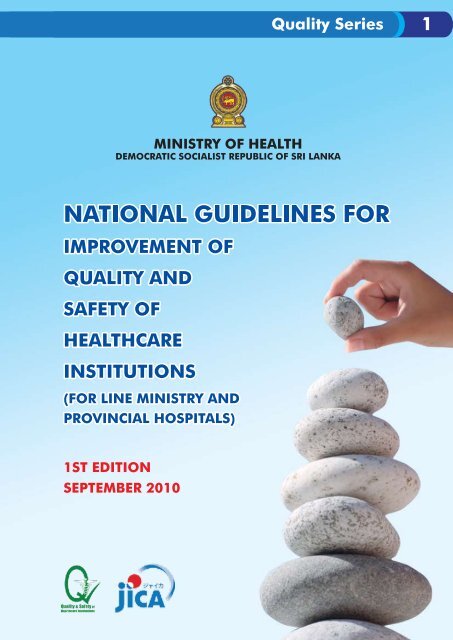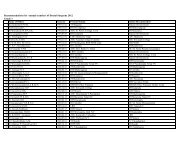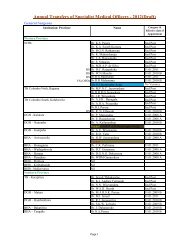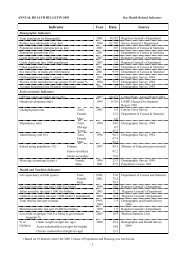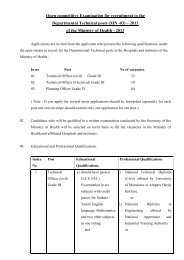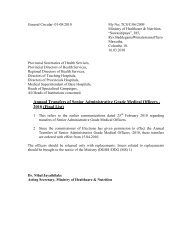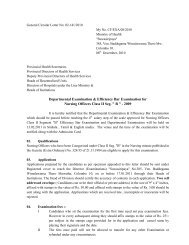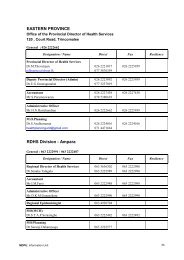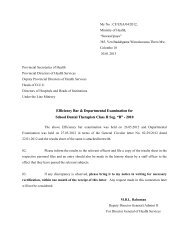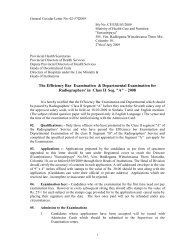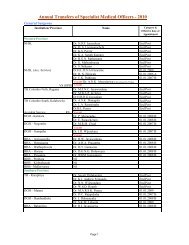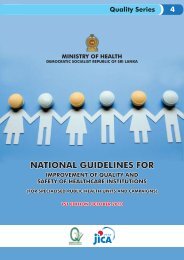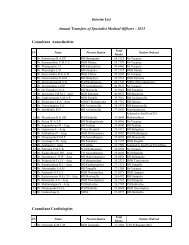National Guidelines for Improvement of Quality and Safety of ...
National Guidelines for Improvement of Quality and Safety of ...
National Guidelines for Improvement of Quality and Safety of ...
Create successful ePaper yourself
Turn your PDF publications into a flip-book with our unique Google optimized e-Paper software.
<strong>Quality</strong> Series No.1<strong>National</strong> <strong>Guidelines</strong> <strong>for</strong><strong>Improvement</strong> <strong>of</strong> <strong>Quality</strong> <strong>and</strong> <strong>Safety</strong> <strong>of</strong> Healthcare Institutions(For Line Ministry <strong>and</strong> Provincial Hospitals)First EditionEdited by:Dr. Wimal JayanthaDDG/Planning, Ministry <strong>of</strong> HealthDr. S. SridharanDirector OD, Ministry <strong>of</strong> HealthMr. Shogo KanamoriJICA Expert on Medical Services AdministrationSeptember 2010
COPYRIGHT © Management Development & Planning UnitMinistry <strong>of</strong> Health385 Baddegama Wimalawansa Thero Mawatha., Colombo 10, Sri LankaSeptember 2010<strong>National</strong> Library <strong>of</strong> Sri Lanka Cataloguing in Publication Data<strong>Quality</strong> Series No.1<strong>National</strong> <strong>Guidelines</strong> <strong>for</strong> <strong>Improvement</strong> <strong>of</strong> <strong>Quality</strong> <strong>and</strong> <strong>Safety</strong> <strong>of</strong> Healthcare Institutions (<strong>for</strong> LineMinistry <strong>and</strong> Provincial Hospitals)ISBN: 978-955-9093-99-2Printed in Sri LankaThis Publication is sponsored by:Japan International Cooperation Agency (JICA)
PrefaceSri Lanka provides free healthcare services to all the citizens irrespective <strong>of</strong> their status, income orgeographic location, <strong>and</strong> has achieved remarkable health outcomes, particularly relative toneighbouring countries with a similar income range. Nevertheless, there are certain drawbacks in thehospital-based healthcare delivery system which have affected the quality <strong>and</strong> efficiency <strong>of</strong> its servicesas demonstrated by overcrowding in the higher level institutions, deficiencies <strong>of</strong> amenities <strong>and</strong> patientdissatisfaction.The <strong>National</strong> <strong>Guidelines</strong> <strong>for</strong> <strong>Improvement</strong> <strong>of</strong> <strong>Quality</strong> <strong>and</strong> <strong>Safety</strong> <strong>of</strong> Healthcare Institutions provide acomprehensive set <strong>of</strong> quality <strong>and</strong> safety st<strong>and</strong>ards <strong>and</strong> af<strong>for</strong>dable measures to improve the hospitalservices. All the hospitals in Sri Lanka are there<strong>for</strong>e expected to be fully oriented on these <strong>Guidelines</strong><strong>and</strong> prepared to improve their service delivery structure <strong>and</strong> process. Needless to say, the strongcommitment <strong>of</strong> heads <strong>of</strong> institutions, PDHSs <strong>and</strong> RDHSs is critical in achieving the goals aimed bythese <strong>Guidelines</strong>.I wish to thank all the stakeholders involved in the development <strong>of</strong> this document as well as JapanInternational Cooperation Agency (JICA) <strong>for</strong> its technical assistance. In particular, I am grateful to DrWimal Jayantha, DDG/Planning, who supervised the whole developmental process, Dr S. Sridharan,Director OD, who led <strong>and</strong> facilitated the drafting work, <strong>and</strong> Mr. Shogo Kanamori, JICA Expert onMedical Services Administration, who provided coordinative <strong>and</strong> technical assistance.Dr. Ravindra RuberuSecretaryMinistry <strong>of</strong> Health20 September 2010
AcknowledgementThe Ministry <strong>of</strong> Health acknowledges the following members <strong>for</strong> their technical inputs <strong>and</strong> logistic supportthrough a series <strong>of</strong> the workshops to develop the content <strong>of</strong> this document.Dr. Aluthweera, Champa; Coordinator <strong>for</strong> <strong>National</strong> <strong>Quality</strong> Assurance Programme, Ministry <strong>of</strong> HealthMrs. Amarasinghe, K.S.N.; Matron, <strong>National</strong> Hospital Sri LankaDr. Ariyadasa, Hirantha; Research Assistant, JICA Advisor’s OfficeDr. De Silva, Susantha; Public Health ConsultantMs. Devashanthini, V.P.; Chief Pharmacist, Medical Supplies Department, Ministry <strong>of</strong> HealthMr. Dissanayake, Chaturanga; Project Assistant, JICA Advisor’s OfficeDr. Fern<strong>and</strong>o, Rani; Director, Castle Street Hospital <strong>for</strong> WomenDr. Gamage, Rehan; Research Assistant, JICA Advisor’s OfficeDr. Gamage, S.A.K.; Director MS, Ministry <strong>of</strong> HealthDr. Gamlath, G.; MS, DGH KegalleDr. Gunasekera, S.C.; SMO, Castle Street Hospital <strong>for</strong> WomenDr. Gunasekara, Vijith; Deputy Director, Lady Ridgeway HospitalDr. Hewageeganage, Neelamanie Rajapakse; PDHS Uva ProvinceDr. Jayanath, B.L.D.; MOIC, PU MadampeDr. Jayantha, Wimal; DDG (Planning), Ministry <strong>of</strong> HealthDr. Jayasinghe, Lanka; MS, DGH AmparaMr. Kanamori, Shogo; JICA Expert on Medical Services AdministrationDr. Kar<strong>and</strong>agoda, Wimal; Director (Medical services), Lanka Hospitals Ltd.Dr. Pannila, V.S.P.; Director Laboratory Services, Ministry <strong>of</strong> HealthDr. Perera, Susie; Director Policy Analysis & Development, Ministry <strong>of</strong> HealthDr. Rajamanthrie, M.; Director, Lady Ridgeway HospitalDr. Samarage, Sarath; Consultant, WHO Sri LankaMrs. Samaranayake, S.G.; Director Nursing Education, Ministry <strong>of</strong> HealthDr. Senanayake, Lakshman; Consultant, Hospital Efficiency <strong>and</strong> <strong>Quality</strong>, HSDP / WB ProjectMr. Shantha, M.P.S.; Chief Radiographer, Lady Ridgeway HospitalDr. Sridharan, S.; Director Organizational Development, Ministry <strong>of</strong> HealthMr. Thilakasiri, M.; Senior Consultant, SLIDADr. Tissera, W.A.A.; Director, Training, Ministry <strong>of</strong> HealthDr. Wickramanayake, Kapila; Director TCS, Ministry <strong>of</strong> HealthDr. Wijerathne, Lalitha; MO/QMU, DGH GampahaDr. Wijesinghe, W.A.K.; RDHS, Kegalle DistrictMr. Withanage, Kithsiri; Superintendent MLT, <strong>National</strong> Hospital Sri LankaThis document has been field tested at 7 hospitals including DGH Nawalapitiya, PU Thiththapajjala,DGH Nuwara Eliya, BH Dickoya, DGH Matale, BH Dambulla <strong>and</strong> DH Galewela in Central Province,<strong>and</strong> finalized by incorporating feedbacks from those pilot hospitals. The Ministry <strong>of</strong> Health appreciates theheads <strong>of</strong> these hospitals <strong>for</strong> their cooperation throughout the field testing process, the authorities in theCentral Province including Dr. Shanthi Samarasinghe, PDHS Central Province; Dr. P.M.A.Samarakkody, Deputy-PDHS Central Province, Dr. V.S.K. Subasinghe, RDHS Nuwara Eliya; Dr.W.G.A. Dissanayake, RDHS K<strong>and</strong>y; <strong>and</strong> Dr. L. Dissyanayake, RDHS Matale <strong>for</strong> their leadership <strong>and</strong>supervision <strong>of</strong> the work, <strong>and</strong> Dr. Sameera Athapattu, Medical Officer, PDHS Office, Central Province <strong>for</strong>the coordination <strong>of</strong> the overall activities.In addition, the Ministry <strong>of</strong> Health extends special thanks to Japan International Cooperation Agency(JICA) <strong>for</strong> its technical <strong>and</strong> financial assistance in development <strong>of</strong> this document under “Project on<strong>Improvement</strong> <strong>of</strong> <strong>Quality</strong> <strong>and</strong> <strong>Safety</strong> <strong>of</strong> Healthcare Institutions in Sri Lanka”.
TABLE OF CONTENTS1. Introduction ……………………………………………………………………………….. 11.1. Target Institutions ……………………………………………………………………… 11.2. The <strong>Guidelines</strong> in the Context <strong>of</strong> <strong>Quality</strong> Assurance Programme ………………... 12. Arrangements <strong>for</strong> <strong>Improvement</strong> <strong>of</strong> <strong>Quality</strong> <strong>and</strong> <strong>Safety</strong> in Hospitals …………….. 32.1. Establishment <strong>of</strong> <strong>Quality</strong> Management Unit (QMU) ……………………………….. 33. Hospital <strong>Quality</strong> <strong>and</strong> <strong>Safety</strong> St<strong>and</strong>ards ……………………………………………….. 4I. Internal <strong>and</strong> External Customer Environment (5S) ………………………………. 61. Seiri (Sorting)2. Seiton (Organisation)3. Seiso (Cleaning with Meaning <strong>and</strong> <strong>for</strong> Beautifying)4. Seiketsu (St<strong>and</strong>ardisation)5. Shitsuke (Training & Self-Discipline)II. Services involving Patient Contacts ……………………………………………….. 166. Reception area7. Immediate service points <strong>and</strong> frontline services8. Responsiveness9. Inpatient care services10. Diagnostic services11. Medical/pharmaceutical supplies <strong>and</strong> equipment management12. Mortuary serviceIII. Overall <strong>Quality</strong> <strong>and</strong> <strong>Safety</strong> <strong>Improvement</strong> ………………………………………….. 3013. Infection control14. Waste management15. Medical record16. Health education activities17. Leadership <strong>and</strong> management18. Productivity <strong>and</strong> quality improvement programmeANNEXES ……………………………………………………………………………………….. 37ANNEX 1: Isles <strong>for</strong> Stationeries ………………………………………………………….. 37ANNEX 2: St<strong>and</strong>ardised Colour Codes ………………………………………………….. 38ANNEX 3: Emergency Tray Checklist (Sample) …….……………………………….…. 39ANNEX 4: Discharge Checklist (Sample) …….………………….……………………... 41ANNEX 5: Cleaning Checklist (Sample) …...……………………………………………. 42ANNEX 6: CSSD Service Flowchart …………………………………………………….. 43ANNEX 7: Visual Control Scheme <strong>for</strong> CSSD …………………………………………… 44ANNEX 8: Protocol <strong>for</strong> Hazardous Waste Management ………………………………. 45ANNEX 9: Patient <strong>and</strong> Employee Satisfaction Survey Forms (Sample) …………….. 47APPENDIX: General Circular on <strong>National</strong> <strong>Quality</strong> Assurance Programme in Health 57
1. <strong>Guidelines</strong> <strong>for</strong> ExternalMonitoring <strong>and</strong> EvaluationDDG/Planning- External monitoring system- <strong>National</strong> quality award systemDirector Organisational DevelopmentGuidance &MonitoringGuidance &MonitoringPDHS/RDHSGuidance &MonitoringLine Ministry HospitalsThisGuidelineDocumentProvincial Hospitals2. <strong>Guidelines</strong> <strong>for</strong> <strong>Improvement</strong><strong>of</strong> <strong>Quality</strong> <strong>and</strong> <strong>Safety</strong>- Organizational arrangements- <strong>Quality</strong> <strong>and</strong> safety st<strong>and</strong>ards &checklist2
2. Arrangements <strong>for</strong> <strong>Improvement</strong> <strong>of</strong> <strong>Quality</strong> <strong>and</strong> <strong>Safety</strong> inHospitalsIn order to initiate the quality <strong>and</strong> safety improvement programme, organizational arrangements withinhospitals need to be modified. The critical step in this respect is to establish a <strong>Quality</strong> ManagementUnit within each hospital. The <strong>Quality</strong> Management Unit (QMU) serves as the secretariat <strong>for</strong>organizing training activities on quality <strong>and</strong> safety improvements as well as implementation,monitoring <strong>and</strong> evaluation <strong>of</strong> the programme in the hospital. In addition, at the ward/unit level, Work<strong>Improvement</strong> Teams (WITs) are to be <strong>for</strong>med to implement the programme. The <strong>Quality</strong> ManagementTeam, consisting <strong>of</strong> the Hospital Director, QMU staff <strong>and</strong> the leaders <strong>of</strong> the WITs will serve as thedecision making body. Suggestive organizational arrangements are provided in the table below.<strong>Quality</strong> Management Team <strong>Quality</strong> Management Unit(QMU)Work <strong>Improvement</strong> Teams(WIT)Unit QMU Respective wards <strong>and</strong> otherunitsMembers - Hospital Director - 1-3 full-time staff - All staff members <strong>of</strong> the- QMU staffrelevant units- Leaders <strong>of</strong> WITsLeader Hospital Director MO or NO A committed staff member2.1. Establishment <strong>of</strong> <strong>Quality</strong> Management Unit (QMU)All hospitals need to have a dedicated QMU. According to the “General Circular No.01-29/2009” <strong>of</strong>the Ministry <strong>of</strong> Healthcare & Nutrition dated 22 September 2009, QMU is to coordinate the qualityassurance <strong>and</strong> client safety program <strong>of</strong> hospitals. Its functions described in the Circular aresummarized below. The original Circular document is attached as APPENDIX.(1) Strengthening institutional setup <strong>and</strong> staff participation in the quality programme• Facilitating management leadership in the quality programme• Establishing Work <strong>Improvement</strong> Teams (WIT)/<strong>Quality</strong> Circles• Training Work <strong>Improvement</strong> Teams (WIT)• Facilitating involvement <strong>of</strong> medical consultants in the quality improvement process(2) Building staff capacity <strong>and</strong> awareness• Conducting quality <strong>and</strong> safety improvement workshops <strong>for</strong> staff members• Facilitating in-service training programmes• Maintaining database <strong>of</strong> staff training• Promoting a quality culture by introducing 5S concept leading towards Total <strong>Quality</strong>Management (TQM)• Promoting environmental friendly hospitals3
(3) Streamlining management <strong>of</strong> equipment <strong>and</strong> supplies• Developing annual procurement plans <strong>for</strong> different variety <strong>of</strong> purchases• Ensuring quality <strong>of</strong> supplies by encouraging maintenance contract agreements <strong>for</strong> supportservices• Organizing <strong>and</strong> updating supplier <strong>and</strong> maintenance in<strong>for</strong>mation system(4) Management <strong>of</strong> the quality programme• Assisting the preparation <strong>of</strong> strategic plans <strong>of</strong> the hospital with the focus on quality <strong>and</strong>safety improvement aspects (e.g. reduction <strong>of</strong> waiting times, instituting a smooth patient flow,infection control <strong>and</strong> proper waste disposal)• Facilitating adherence to st<strong>and</strong>ards, guidelines <strong>and</strong> protocols relevant to customer/patientcare including clinical pathways• Maintaining computer based data on quality <strong>and</strong> safety (e.g. patient accidents <strong>and</strong> adverseevents, near misses re-admissions, case fatality rates, complication arising from medical <strong>and</strong>surgical procedures, referrals, adverse events following immunization <strong>and</strong> transfers, etc.)• Conducting customer satisfaction surveys <strong>and</strong> employee satisfaction surveys• Encouraging “suggesting scheme” in the hospital• Preparing half yearly/quarterly bulletins <strong>and</strong> annual per<strong>for</strong>mance reports• Conducting per<strong>for</strong>mance reviews• Monitoring the progress <strong>of</strong> the quality programme referring to the <strong>Quality</strong> <strong>and</strong> <strong>Safety</strong>St<strong>and</strong>ards in these <strong>Guidelines</strong>• Promoting studies, research <strong>and</strong> medical audits in the hospitals3. Hospital <strong>Quality</strong> <strong>and</strong> <strong>Safety</strong> St<strong>and</strong>ardsThis chapter provides hospital quality <strong>and</strong> safety st<strong>and</strong>ards to which all the hospitals shall adhere.They are divided into three aspects <strong>and</strong> 18 areas as follows:I. Internal <strong>and</strong> External Customer Environment (5S)1. Seiri (Sorting)2. Seiton (Organisation)3. Seiso (Cleaning with Meaning <strong>and</strong> <strong>for</strong> Beautifying)4. Seiketsu (St<strong>and</strong>ardisation)5. Shitsuke (Training & Self-Discipline)II. Services involving Patient Contacts6. Reception area7. Immediate service points <strong>and</strong> frontline services8. Responsiveness9. Inpatient care services10. Diagnostic services4
11. Medical/pharmaceutical supplies <strong>and</strong> equipment management12. Mortuary serviceIII. Overall <strong>Quality</strong> <strong>and</strong> <strong>Safety</strong> <strong>Improvement</strong>13. Infection control14. Waste management15. Medical record16. Health education activities17. Leadership <strong>and</strong> management18. Productivity <strong>and</strong> quality improvement programmeThese st<strong>and</strong>ards will be referred to whenever a hospital conducts quality <strong>and</strong> safety improvementactivities as well as internal audit. They are also in line with the criteria <strong>for</strong> external audits <strong>and</strong> <strong>for</strong>selection <strong>of</strong> the <strong>National</strong> <strong>Quality</strong> Award recipients.5
I. Internal <strong>and</strong> External Customer Environment (5S)WardsOPD/ClinicsLaboratoryEntrance, reception& passagewaysOfficeStoresRecord RoomOutsideOthersArea <strong>of</strong> Concern St<strong>and</strong>ards Measurable Elements1 Seiri (Sorting)Eliminating unnecessary items from the workplace that are not needed <strong>for</strong> current process in the hospital.1.1 Outside <strong>and</strong>inside premises1.2 Walls <strong>and</strong>notice boards1.1.1 Unwanted itemsremoved from theworkplace1.1.2 The floors <strong>and</strong>passageways in thepublic areas equippedwith garbage bins <strong>for</strong>general waste <strong>and</strong> keptfree <strong>of</strong> litters1.1.3 Unwanted trees <strong>and</strong>branches removed1.2.1 Walls being free <strong>of</strong> oldposters, pictures orcalendars.- An established process in sorting wanted <strong>and</strong> unwanteditems is present.- A proper process <strong>for</strong> condemning items is present.- Unwanted items are not left in the workplace or markedwith tags.‣ Red tags <strong>for</strong> those items to be disposed‣ Orange tags <strong>for</strong> those items under consideration.- Tops <strong>and</strong> insides <strong>of</strong> all cupboards, shelves, tables <strong>and</strong>drawers are free <strong>of</strong> unwanted /irrelevant items.- Garbage bins <strong>for</strong> general waste are in place <strong>and</strong> colourcoded.- The time <strong>for</strong> removing litters from the garbage bins areindicated.- The place is free <strong>of</strong> litter.- Trees which are obstructing the drainage are removed.- Tree branches above the ro<strong>of</strong> <strong>and</strong> over the electric <strong>and</strong>telephone wires are trimmed.- Posters/pictures are not fading or torn.- In<strong>for</strong>mation on posters/pictures is not obsolete.- Calendars are updated.X X X X X X X XX XX X X X X X X XX6
I. Internal <strong>and</strong> External Customer Environment (5S)WardsOPD/ClinicsLaboratoryEntrance, reception& passagewaysOfficeStoresRecord RoomOutsideOthersArea <strong>of</strong> Concern St<strong>and</strong>ards Measurable Elements1.2.2 Notice boards being free<strong>of</strong> obsolete notices- Removal instructions are in place.- The removal instruction is complied.- Notice boards are categorized according to the staffmembers/needs.- Responsible persons <strong>for</strong> each notice board areidentified.- The alignment <strong>and</strong> an X-Y axis tool are maintained inthe notice board.X X X X X X X X2 Seiton (Organisation)Ensuring all the items that have been sorted are arranged <strong>and</strong> placed in pre-assigned positions in order to facilitate efficiency at work.2.1 Hospital <strong>and</strong>service unitidentification2.2 Directionalindications2.3 Labelling <strong>and</strong>marking2.1.1 A hospital name board<strong>and</strong> a site map available2.2.1 Directional boardsavailable at everyjunction2.2.2 Corridors clearly markedwith entrances <strong>and</strong> exitlines, curved dooropenings, <strong>and</strong> direction<strong>of</strong> travel2.3.1 Rooms <strong>and</strong> toilets clearlyidentified with labels- A hospital name board is displayed outside in all threelanguages.- A site map is displayed at the entrance / reception areain all three languages.- Directional boards are displayed at every junctionoutside <strong>and</strong> inside <strong>of</strong> the hospital to all facilities from theentrance in all three languages.- Entrance <strong>and</strong> exit lines are placed <strong>for</strong> OPD/clinics.- Curved door openings are marked at entrance doors torooms.- The direction <strong>of</strong> travel is indicated on the corridors.- The sliding doors are provided with directional arrows.- All rooms <strong>and</strong> toilets are identified with labels, nameboards or numbers.X XXXX X X X X X X X7
I. Internal <strong>and</strong> External Customer Environment (5S)WardsOPD/ClinicsLaboratoryEntrance, reception& passagewaysOfficeStoresRecord RoomOutsideOthersArea <strong>of</strong> Concern St<strong>and</strong>ards Measurable Elements2.4 Placing <strong>and</strong>parking rules2.3.2 Stores <strong>and</strong> storageareas properly organised2.3.3 Switches <strong>and</strong> fans easilyidentified2.4.1 Equipment <strong>and</strong> toolsbeing kept in originalplaces after use- Items in stores <strong>and</strong> storage areas are kept in shelves,racks or bins <strong>and</strong> clearly marked.- Shelf grids are marked with reference numbers/names<strong>for</strong> easy retrieval <strong>of</strong> items.- All stationeries in the cupboard are kept in placesidentified with symbols <strong>and</strong> marks (visual control <strong>of</strong>stationeries).- Items are stored in an alphabetical order <strong>and</strong> in a logicalmanner (left to right / top to bottom).- A mechanism to replenish items is organized with colourcodes:‣ Maximum stock level: Green‣ Reorder stock level: Orange‣ Minimum stock level: Red- All switches <strong>and</strong> fan regulators are labelled accordingly.- A separate electrical point plan is in place <strong>for</strong> each roomat entrance.- ‘Isles’ are identified <strong>for</strong> each equipment <strong>and</strong> tool to bekept after use with the straight line method <strong>and</strong> shadowdrawings displayed.- A mechanism to identify persons removing items from‘isles’ Items is in place.X X X X X XX X X X X X XX X X X X X XAn example <strong>of</strong> ‘Isles’ is shown in “ANNEX 1: Isles <strong>for</strong>Stationeries”.8
I. Internal <strong>and</strong> External Customer Environment (5S)WardsOPD/ClinicsLaboratoryEntrance, reception& passagewaysOfficeStoresRecord RoomOutsideOthersArea <strong>of</strong> Concern St<strong>and</strong>ards Measurable Elements2.4.2 Files <strong>and</strong> foldersarranged using themistake pro<strong>of</strong>ing concept2.4.3 Parking areas <strong>for</strong> mobileequipment specified <strong>and</strong>marked2.4.4 Parking areas <strong>for</strong>vehicles specified <strong>and</strong>marked- Files <strong>and</strong> box folders are arranged using the mistakepro<strong>of</strong>ing concept to facilitate identification <strong>of</strong> particularfiles (within 30 seconds) <strong>and</strong> storing in original places.- Parking areas are specifically marked <strong>for</strong>:‣ Pallets/trolleys‣ Wheelchairs‣ Stretchers‣ Garbage bins‣ Suckers <strong>and</strong> oxygen trolleys- Designated parking places are available <strong>for</strong>ambulances.- Vehicle flows in the hospital areas are identified <strong>and</strong>marked.- Sign boards <strong>for</strong> vehicles <strong>of</strong> differently-abled persons arein place.- An illuminated sign board (e.g. with “P” sign) <strong>for</strong> thevehicle park is available at night.X X X X XX X XX9
I. Internal <strong>and</strong> External Customer Environment (5S)WardsOPD/ClinicsLaboratoryEntrance, reception& passagewaysOfficeStoresRecord RoomOutsideOthersArea <strong>of</strong> Concern St<strong>and</strong>ards Measurable Elements3 Seiso (Cleaning with Meaning <strong>and</strong> <strong>for</strong> Beautifying)Cleaning up one’s workplace completely to eliminate dust on floors, machines or equipment.3.1 Generalappearance <strong>of</strong>cleanliness3.1.1 Hospital premisesmaintained with healthy<strong>and</strong> safe environment <strong>for</strong>internal <strong>and</strong> externalcustomers3.1.2 Floors, walls, windows<strong>and</strong> curtain & otherfittings being kept clean3.1.3 Toilets are clean <strong>and</strong> inworking order3.1.4 Changing rooms <strong>for</strong>patients being kept clean<strong>and</strong> in working order- The garden is properly maintained <strong>and</strong> l<strong>and</strong>scaping isdone by a gardener.- Drains are not leaking or overflowing.- Stagnation <strong>of</strong> water is avoided in all drains.- Unpleasant odour is not produced from the hospitalwaste site or other places.- The visible parts <strong>of</strong> the ro<strong>of</strong> are free <strong>of</strong> unwanted items.- The cleanliness is maintained at:‣ Floors‣ Walls‣ Windows‣ Curtains‣ Other fittings‣ Gutters- A cleaning checklist is available <strong>and</strong> updated.- Unpleasant odour is not experienced in toilets.- Toilet facilities are kept ready <strong>for</strong> use.- A cleaning checklist is available <strong>and</strong> updated.- Adequate ventilation is provided in all the toilets.- A cleaning checklist is available <strong>and</strong> updated.X X X X X X XX X X X XX X TheatreX10
I. Internal <strong>and</strong> External Customer Environment (5S)WardsOPD/ClinicsLaboratoryEntrance, reception& passagewaysOfficeStoresRecord RoomOutsideOthersArea <strong>of</strong> Concern St<strong>and</strong>ards Measurable Elements3.2 Cleaning <strong>of</strong>machines,equipment,tools <strong>and</strong>furniture3.3 Cleaningpractice3.2.1 The cleanliness <strong>of</strong>buildings, machines,equipment, tools <strong>and</strong>furniture maintained3.3.1 An organised cleaningsystem in place3.3.2 Cleaning tools <strong>and</strong>detergents properlystored- The high level <strong>of</strong> cleanliness is maintained with novisible dirt:‣ Buildings‣ Ambulances‣ Other hospital vehicles‣ Medical equipment‣ Furniture (tables, desks, chairs, etc.)- The following tools <strong>and</strong> documents aredisplayed/available:‣ Cleaning responsibility chart‣ Cleaning schedules‣ Cleaning guidelines- The above tools <strong>and</strong> documents are updated monthly.- Proper storage facilities <strong>for</strong> cleaning tools <strong>and</strong>detergents are available.- Appropriate <strong>and</strong> necessary chemicals are used <strong>for</strong>management <strong>of</strong> body fluid spills.- Cleaning tools <strong>for</strong> outside areas/toilets <strong>and</strong> inside areasare separated.X X X XX X X X X X X XX X X X X X X X4 Seiketsu (St<strong>and</strong>ardization)Generating mechanisms to maintain the three Ss (Seiri, Seiton <strong>and</strong> Seiso) by developing procedures, schedules <strong>and</strong> tools <strong>for</strong> continuous assessment <strong>and</strong>regular audit.4.1 St<strong>and</strong>ardizedvisuals4.1.1 Sign boards <strong>and</strong>directional boardsst<strong>and</strong>ardised- All sign boards <strong>and</strong> directional boards are st<strong>and</strong>ardisedwith proper alignment <strong>and</strong> consistent fonts, <strong>and</strong> bycolour codes.X X X X X X11
I. Internal <strong>and</strong> External Customer Environment (5S)WardsOPD/ClinicsLaboratoryEntrance, reception& passagewaysOfficeStoresRecord RoomOutsideOthersArea <strong>of</strong> Concern St<strong>and</strong>ards Measurable Elements4.1.2 Drug cupboardsst<strong>and</strong>ardised in all units4.1.3 Arrangements <strong>of</strong> surgicalsupplies st<strong>and</strong>ardised inall units4.1.4 Identification labelsplaced on all machines<strong>and</strong> equipment4.1.5 Caution signs displayedat appropriate places- Drugs are sorted in a logical manner.‣ vital, essential <strong>and</strong> normal‣ accountable, non-accountable, <strong>and</strong> special & extra- Drugs are arranged in alphabetical order <strong>and</strong> left-to-rightin all units.- The sterilisation status is indicated <strong>for</strong> surgical supplies.- Surgical supplies are arranged logically (e.g. glovesaccording to sizes <strong>and</strong> in the left-to-right order)All machines <strong>and</strong> equipment have identification labelswith the following in<strong>for</strong>mation:‣ Name <strong>of</strong> the items‣ Identification <strong>and</strong> batch numbers‣ Date <strong>of</strong> acquisition‣ Contact details <strong>of</strong> maintenance company‣ Responsible person <strong>for</strong> maintenance‣ Cost <strong>of</strong> equipment- “Danger” signs are displayed at:‣ Electric switchboards <strong>and</strong> trans<strong>for</strong>mers‣ Radiology/X-ray‣ Liquid oxygen tanks- “Biohazard” signs are displayed at:‣ Laboratories h<strong>and</strong>ling contagious items- “Slopes” sings are displayed at:‣ Wherever there is a slope.- “Slippery” signs with zebra code are placed at:‣ Wet floor after cleaning.X XX X XX X X X X XX X X X X12
I. Internal <strong>and</strong> External Customer Environment (5S)WardsOPD/ClinicsLaboratoryEntrance, reception& passagewaysOfficeStoresRecord RoomOutsideOthersArea <strong>of</strong> Concern St<strong>and</strong>ards Measurable Elements4.1.6 Open <strong>and</strong> shutdirectional labelsavailable on valves <strong>and</strong>doors4.1.7 Waste bins separated,labelled <strong>and</strong>colour-coded- The directional labels are put on:‣ Oxygen tanks‣ Door h<strong>and</strong>les <strong>of</strong> cupboards‣ Theatre taps‣ All other door h<strong>and</strong>les- All the waste bins are separated, labelled <strong>and</strong>colour-coded.The colour-codes are elaborated in “ANNEX 2:St<strong>and</strong>ardised Colour Codes”X X X X X X XX X X X4.1.8 Pipes <strong>and</strong> oxygen/gastanks identified byst<strong>and</strong>ardised visuals- Types <strong>of</strong> pipes can be identified by different colours:‣ Oxygen‣ Compressed air‣ Vacuum- Types <strong>of</strong> tanks can be identified by colours:‣ Oxygen (O2; White)‣ Carbon Dioxide (CO2; Gray)‣ Nitrous Oxide (N2O; Blue)‣ LP Gas- The status <strong>of</strong> tanks (empty or full) can be identified bycolours or tags:‣ Empty: Red‣ Full: BlueTheatre13
I. Internal <strong>and</strong> External Customer Environment (5S)WardsOPD/ClinicsLaboratoryEntrance, reception& passagewaysOfficeStoresRecord RoomOutsideOthersArea <strong>of</strong> Concern St<strong>and</strong>ards Measurable Elements4.2 Maintenance <strong>of</strong>vehicles,machines <strong>and</strong>equipment4.3 <strong>Safety</strong> <strong>and</strong>securitymeasures4.2.1 Vehicles, machines <strong>and</strong>equipment properlymaintained4.3.1 <strong>Safety</strong> measures are inplace <strong>for</strong> electricalcables <strong>and</strong> devices4.3.2 Security measures inplace <strong>for</strong> a fire event- Maintenance schedules <strong>and</strong> records are available <strong>and</strong>updated <strong>for</strong> the following items:‣ Vehicles‣ Machines‣ Hospital equipment- Operational instructions are made available <strong>for</strong>machines <strong>and</strong> equipment.- Electrical wires are sealed or bundled to preventaccidental contacts with human beings.- All switches are properly fixed without anyelectrically-conductive parts exposed.- All electric devices <strong>and</strong> boilers are placed in a safetymanner.- Danger signs (Zebra code or Tiger stripes) are applied- Functional fire extinguishers or s<strong>and</strong> buckets areavailable.- The guidelines or a protocol <strong>for</strong> the fire event isavailable.X X X X XX X X X X X X XX X X X X X X X Kitchen14
I. Internal <strong>and</strong> External Customer Environment (5S)Area <strong>of</strong> Concern St<strong>and</strong>ards Measurable Elements5 Shitsuke (Training & Self-Discipline)Working on 5S as daily routines <strong>and</strong> ensuring that it becomes an integral part <strong>of</strong> the workplace fabric.5.1 Internal audit 5.1.1 Internal audits on thehospital qualityimprovement conductedwith the checklist5.2 Training <strong>and</strong>raisingawareness5.2.1 The hospital staff trainedon 5S5.2.2 A resource centre onhospital qualityimprovement available5.2.3 A 5S Corner available inthe hospital5.2.4 5S promoting competitionsamong employeesorganised5.2.5 A system to give awards towell-per<strong>for</strong>med work unitsavailable- An internal audit sheet on the hospital quality improvement is available.- A team has been appointed to conduct the internal audit.- The internal audit is conducted at least once in three months.- All the hospital staff are trained on 5S.- A programme to train new staff on 5S is available.- A resource centre on 5S, Kaizen <strong>and</strong> CQI related materials is available <strong>for</strong> the hospital staff.- A 5S Corner is organised where the staff have frequent access.- The 5S Corner is updated monthly.- Assessment criteria <strong>for</strong> 5S competitions are prepared <strong>and</strong> practiced.- An event to appreciate best employers is carried out annually.- Assessment criteria to measure the per<strong>for</strong>mance is prepared to select best units <strong>and</strong> best teams.- An event to appreciate best per<strong>for</strong>ming units <strong>and</strong> teams is carried out annually.15
II. Services involving Patient ContactsAreas <strong>of</strong> Concern St<strong>and</strong>ards Measurable Elements6 Reception area6.1 Reception area 6.1.1 An organised receptionavailable6.2 Waiting area 6.2.1 Spacious <strong>and</strong> ventilatedwaiting area available6.2.2 Adequate seating facilitiesavailable with properseating orders- A reception desk is available.- A trained person is in place all the time during the operational hours.- Accurate in<strong>for</strong>mation about the hospital services is dispensed.- Ventilated environment is evident in the waiting area..- The layout <strong>of</strong> the waiting area is well organized.- A sufficient number <strong>of</strong> seating facilities (minimum <strong>of</strong> 1/4 <strong>of</strong> the daily attendance) is available at thewaiting area..- Seating facilities are arranged in order.7 Immediate service points <strong>and</strong> frontline services7.1 Out PatientDepartment &Clinics7.1.1 Examination bedsappropriately arranged7.1.2 The sterility maintained indressing rooms, injectionrooms, etc.7.1.3 Refrigerated drugs <strong>and</strong>vaccines maintained at anoptimum temperature7.1.4 Drugs properly arranged<strong>and</strong> their availabilitystreamlined7.1.5 A survey to measurewaiting time <strong>of</strong> patients atOPD conducted regularly7.1.6 A proper referral systemavailable- Examination beds are screened <strong>for</strong> privacy.- Examination beds have clean mattress <strong>and</strong> linen.- A h<strong>and</strong> washing sink is available with clean towels <strong>and</strong> soap, <strong>and</strong> used.- Surgical gloves are available, arranged according to their sizes, <strong>and</strong> used to undertake wound dressing.- Sterilised instruments, packets <strong>and</strong> dressings are kept in a cupboard with a written indication <strong>of</strong> sterility.- A refrigerator with a functioning Analog thermometer is available <strong>and</strong> kept at optimum temperature.- Drugs <strong>and</strong> vaccines are stored in their optimum temperatures.- The temperature(s) <strong>of</strong> the refrigerator is measured daily two times a day (8.00am & 4.00 pm) <strong>and</strong>recorded in a book/sheet by a responsible <strong>of</strong>ficer.- Drugs are labelled <strong>and</strong> arranged in a sorted <strong>and</strong> organized manner.- A drug availability register is made available to OPD/clinic doctors <strong>and</strong> updated weekly.- A survey <strong>for</strong>m to measure waiting time <strong>of</strong> patients is available.- A waiting time survey is conducted <strong>and</strong> analyzed monthly.- A report on appropriate actions taken to reduce the waiting time is available.- A list <strong>of</strong> specialized hospitals <strong>and</strong> contact details is available on the wall.- Transfer in-<strong>and</strong>-out record is available <strong>and</strong> updated.- The transfer in-<strong>and</strong>-out statistics are compiled <strong>and</strong> reviewed annually.16
II. Services involving Patient ContactsAreas <strong>of</strong> Concern St<strong>and</strong>ards Measurable Elements7.2 Emergency careunit7.2.1 An emergency care unitfunctioning 24 hours withessential equipment <strong>and</strong>drugs7.2.2 A disaster preparednessprotocol <strong>and</strong> equipmentavailable- The essential equipment is kept in accessible place <strong>and</strong> in working order:‣ ECG <strong>and</strong> defibrillator‣ Nebulising machine‣ Sucker machine‣ Ambubag‣ Laryngoscope‣ ET Tubes <strong>and</strong> Trachaeotomy tubes (arranged logically according to their sizes)- Emergency care guidelines are prepared <strong>and</strong> displayed (at least <strong>for</strong> Anaphylactic Shock <strong>and</strong> CardiacArrest).- A checklist <strong>for</strong> drugs <strong>and</strong> supplies is available.- The checklist is maintained daily <strong>and</strong> there is no expired drug in stock.- A disaster management plan is updated annually.- A disaster management cupboard is available with appropriate items <strong>and</strong> updated monthly.- Files with numbered BHTs, <strong>for</strong>ms <strong>and</strong> tags are kept <strong>for</strong> disaster situation.7.2.3 A triage system available - Existing staff in emergency care unit are trained on triage.7.2.4 A proper referral systemavailable- Triage protocols are available <strong>and</strong> practiced.- Resuscitation facilities are available at triage sites in the hospital.- Sites <strong>for</strong> P1, P2, P3 & P4 are identified in the hospital.- Transfer in-<strong>and</strong>-out record is available <strong>and</strong> updated.- The transfer in-<strong>and</strong>-out statistics are compiled <strong>and</strong> reviewed annually.8 Responsiveness8.1 Overallresponsiveness8.1.1 An appointment systemavailable <strong>for</strong> clinics8.1.2 Clean drinking waterprovided at all times topatients8.1.3 An in<strong>for</strong>mation deskavailable <strong>for</strong> relatives <strong>of</strong>inpatients.- A mechanism to give appointments to clinic patients is available.- The appointment system is properly practiced at clinics.- Clean drinking water is available <strong>for</strong> patients with a water filter/container. Wards/ OPD/Clinics- An in<strong>for</strong>mation desk is available with a trained hospital staff.- In<strong>for</strong>mation is dispensed in an appropriate way.ClinicReception/Wards17
II. Services involving Patient ContactsAreas <strong>of</strong> Concern St<strong>and</strong>ards Measurable Elements8.1.4 A suggestion box <strong>and</strong> aprocedure to take8.2 Responsivenessto in-patients8.3 Responsivenessto specialisedgroupsremedial actions available8.2.1 Separate dining areasavailable <strong>for</strong> inpatients8.2.2 Bed linen changedproperly8.2.3 A changing room available<strong>for</strong> inpatients8.2.4 Food provided in a propermanner8.2.5 Patient trolleys providedwith mattresses8.3.1 Secure access provided<strong>for</strong> the differently-abled<strong>and</strong> senior citizens- A suggestion box is available with a pen <strong>and</strong> a designed <strong>for</strong>m/writing pad.- Suggestions are being reviewed at monthly <strong>for</strong>ums/meetings involving relevantdecision makers.- A record book <strong>of</strong> actions taken responding to the suggestions is available <strong>and</strong> updated.- Separate dining areas are available <strong>for</strong> in-patients. Wards- Bed linen is changed on the following occasions:‣ At every discharge <strong>of</strong> patients.‣ When there is a blood spot or body secretion on the linen.‣ When a reasonable request is made by the patients.Entrance,reception &passagewaysWards- A properly covered changing room is available <strong>for</strong> the inpatients. Wards- Food to the patients are transported <strong>and</strong> kept in the ward in closed containers.- Food is distributed to the patients in a clean environment which is not accessible t<strong>of</strong>lies.Wards- All the patient trolleys are provided with mattresses. WardEntrance,reception &- Separate toilets are available <strong>for</strong> the differently-abled.- Special access at stairways is available <strong>for</strong> the differently-abled.- Priority counters <strong>for</strong> differently-abled <strong>and</strong> senior citizens are available.passagewaysClinic,Entrance,reception &passageways18
II. Services involving Patient ContactsAreas <strong>of</strong> Concern St<strong>and</strong>ards Measurable Elements9 Inpatient care services9.1 General Ward 9.1.1 An updated summary <strong>of</strong>the statistics displayed inthe ward9.1.2 Inpatients attendedappropriately onadmission to wards9.1.3 An emergency traysystematically arranged<strong>and</strong> functioning- The statistical summaries <strong>of</strong> the last year, the last month <strong>and</strong> yesterday are displayed in the ward <strong>and</strong>updated on:‣ Number <strong>of</strong> beds‣ Number <strong>of</strong> admissions‣ Number <strong>of</strong> discharges‣ Bed occupancy rate‣ Number <strong>of</strong> transfers (in <strong>and</strong> out)‣ Number <strong>of</strong> deliveries (Post-natal wards only)- Stamping on BHTs <strong>of</strong> patients who require urgent medical attention is done at OPD.- The general status <strong>and</strong> vital signs are measured <strong>and</strong> recorded on admission to wards <strong>for</strong> all the patients.- Patients with “HO to See Stat” are consulted by doctors within reasonable time.- Allocation <strong>of</strong> nurses to patients is clearly indicated in the ward.- An emergency tray is available with essential supplies, equipments, solutions <strong>and</strong> drugs.- A check list <strong>for</strong> the emergency tray items is available <strong>and</strong> checked at least once a day.- A responsible <strong>of</strong>ficer is indicated <strong>for</strong> the maintenance <strong>of</strong> the emergency tray.A sample emergency tray item checklist is attached in “ANNEX 3: Emergency Tray Checklist(Sample)”.9.1.4 Nursing stations arrangedto respond to emergencyoccasions9.1.5 A separate examinationarea available- Nurses can observe acute patients <strong>and</strong> those who require close monitoring from the nursing station allthe time.- Patients are easily accessible from the nursing station in emergency occasions.- An examination bed is available.- The examination area is screened <strong>for</strong> privacy.9.1.6 BHTs properly written - Date <strong>and</strong> time are written at every entry to BHTs.- BHTs are page-numbered.- All the entries to BHTs are clearly written.- Drug charts <strong>and</strong> fluid balance charts are made up to date on BHTs.- Complete diagnosis is written on the BHTs upon discharge <strong>of</strong> patients.19
II. Services involving Patient ContactsAreas <strong>of</strong> Concern St<strong>and</strong>ards Measurable Elements9.1.7 Ward rounds conducted - Ward rounds are conducted twice a day (morning <strong>and</strong> evening).twice a day- Observations during the ward rounds <strong>and</strong> the time are entered in the BHTs.9.1.8 H<strong>and</strong>ing-over <strong>and</strong>taking-over <strong>of</strong> patientsproperly done upon shiftchanges9.1.9 Arrangements to in<strong>for</strong>mMedical Officers duringemergencies beingsatisfactory at all times9.1.10 Availability <strong>of</strong> drugsin<strong>for</strong>med to all clinicians9.1.11 Arrangements todischarge patients beingadequate- A h<strong>and</strong>ing-over/taking-over register is available.- Patient details are written on the register <strong>and</strong> h<strong>and</strong>ed over with signature to the leader <strong>of</strong> the next shift.- A list <strong>of</strong> the on-call doctors is updated <strong>and</strong> contact numbers are made available <strong>for</strong> nurses <strong>and</strong>displayed.- An Intercom <strong>and</strong>/or a communication book are available <strong>and</strong> functioning.- A drug availability register is made available <strong>for</strong> doctors <strong>and</strong> updated weekly.- A printed discharge checklist is available <strong>and</strong> filled <strong>for</strong> each patient <strong>and</strong> attached to the BHT at everydischarge.- Vital in<strong>for</strong>mation is included in the checklist.- Patient discharge in<strong>for</strong>mation including date, time <strong>and</strong> signature is written on BHTs.A sample discharge checklist is attached in “ANNEX 4: Discharge Checklist (Sample)”.20
II. Services involving Patient ContactsAreas <strong>of</strong> Concern St<strong>and</strong>ards Measurable Elements9.1.12 Relevant registersmaintained <strong>and</strong> updated.- The following registers are available <strong>and</strong> updated:‣ Ward Admission Book‣ Call Book‣ Death register‣ Health education book‣ Infection control book <strong>and</strong> infection control audit checklist‣ Broken <strong>and</strong> condemning item book (Health 500 <strong>and</strong> 503)‣ Accident <strong>and</strong> incident register‣ Readmission book‣ Drugs book‣ Communicable diseases notification register‣ Discharge register‣ Correspondence book‣ Checklist <strong>for</strong> special <strong>and</strong> essential apparatus‣ Transfer in <strong>and</strong> out book‣ Midnight report book‣ Staff roster by category9.1.13 A death record maintained - A death record is completed with cause <strong>of</strong> death, underlying cause <strong>and</strong> probable cause.9.1.14 An updated cleaningchecklist available- A cleaning checklist is displayed <strong>and</strong> made visible to the staff members.- Responsible personnel <strong>for</strong> cleaning is identified <strong>and</strong> mentioned in the cleaning checklist.- The cleaning checklist is updated weekly.A sample cleaning checklist is provided in “ANNEX 5: Cleaning Checklist (Sample)”.21
II. Services involving Patient ContactsAreas <strong>of</strong> Concern St<strong>and</strong>ards Measurable Elements9.2 Intensive careunit9.2.1 A functioning intensivecare unit available withessential equipment9.2.2 H<strong>and</strong>ing-over <strong>and</strong>taking-over <strong>of</strong> patientsproperly done upon shiftchanges9.3 Operating theatre 9.3.1 An updated summary <strong>of</strong>the statistics displayed inthe operating theatre- A 24 hour consultant coverage is available.- Medical Officers <strong>and</strong> Nursing Officers are assigned accordingly.- The ICU is equipped with the following equipment:‣ ECG <strong>and</strong> defibrillator‣ Nebulising machine‣ Pulse oxymeter‣ Sucker machine‣ Ambubag‣ Laryngoscope‣ Tubes‣ Ventilators‣ Blood gas analyzer‣ ICU beds‣ Medical Gases- An emergency tray is available with essential supplies, solutions <strong>and</strong> drugs <strong>for</strong> every bed.- A communication mechanism to contact all relevant health personnel <strong>and</strong> services is in place in anemergency situation.- A checklist <strong>for</strong> the emergency tray items is available <strong>and</strong> maintained once a day.- Admission <strong>and</strong> discharge criteria to <strong>and</strong> from the intensive care unit is available.- A h<strong>and</strong>ing-over/taking-over register is available.- Patient details are written on the register <strong>and</strong> h<strong>and</strong>ed over with signature to the leader <strong>of</strong> the next shift.- The statistical summaries <strong>of</strong> the last year, the last month <strong>and</strong> yesterday are displayed in the operatingtheatre <strong>and</strong> updated on:‣ Number <strong>of</strong> operating beds‣ Number <strong>of</strong> major surgeries according to speciality (Surgery, Obs, Gynae, ENT, EYE etc.,)‣ Number <strong>of</strong> minor surgeries22
II. Services involving Patient ContactsAreas <strong>of</strong> Concern St<strong>and</strong>ards Measurable Elements9.3.2 Infection control protocolsadhered to9.3.3 An effective pre-operativecare available9.3.4 An effective operative careavailable9.3.5 An effective post operativecare available- A copy <strong>of</strong> the “Hospital Infection Control Manual, Sri Lanka College <strong>of</strong> Microbiologists” is available <strong>and</strong>the infection control protocols in Chapter 9 are adhered to.- Sterile areas are available <strong>for</strong> instruments, linen, shoes etc. <strong>and</strong> identified with the visual control method.- A sterilization chart is available in the ICU.- Dirty utility areas are available <strong>for</strong> instruments, linen, shoes etc. <strong>and</strong> identified with the visual controlmethod.- A proper waste segregation mechanism based on the colour coding is available.- Patients from the ward are taken over by operating theatre nurses with countersignatures.- A pre-operative checklist is available <strong>and</strong> adhered to.‣ A printed pre-operative check list is available in the ward.‣ The checklist is filled <strong>and</strong> attached to the BHT at the ward.‣ The checklist is completed when a patient is brought to the operating theatre.‣ The checklist is counterchecked at the theatre reception as well as by an anaesthetist.- A patient identification procedure <strong>and</strong> a mechanism to prevent surgical misadventures are in place.‣ The patient identification tag consisting <strong>of</strong> patient name, BHT No. <strong>and</strong> surgical procedures to beundertaken is available.‣ The patient identification tags are properly filled <strong>and</strong> placed on all the patients on the day <strong>of</strong> thesurgery.‣ The surgical theatre list including patient in<strong>for</strong>mation (patient name, BHT No. <strong>and</strong> surgicalprocedure) <strong>for</strong> a particular day is developed in the ward <strong>and</strong> sent to the operating theatre.- A mechanism to identify different types <strong>of</strong> gases used during anaesthesia is available.- An anaesthetic drug tray is available <strong>and</strong> checked with a checklist by MO Anaesthesia be<strong>for</strong>e every shift.- An emergency drug tray is available <strong>and</strong> checked with a checklist by MO Anaesthesia be<strong>for</strong>e every shift.- The following mechanisms are available.‣ Established pack count mechanism‣ Established equipment count mechanism‣ Mechanism to assess blood loss‣ A functioning ventilation mechanism- A recovery area is available with designated staff.- Essential equipment <strong>and</strong> drugs are available in the recovery area.- Post operative notes are provided in the BHTs.- Patients are h<strong>and</strong>ed over to the ward with countersignatures <strong>of</strong> the ward staff.23
II. Services involving Patient ContactsAreas <strong>of</strong> Concern St<strong>and</strong>ards Measurable Elements9.3.6 The theatre schedule - The theatre schedule <strong>for</strong> a week is made available to hospital staff.properly managed - <strong>Guidelines</strong> <strong>for</strong> emergency surgeries are available <strong>and</strong> practiced.9.3.7 Relevant registersmaintained9.4 Blood bank 9.4.1 A 24-hour blood bankservice available9.4.2 Trained staff availableaccording to the <strong>National</strong>Blood Transfusion Service(NBTS) st<strong>and</strong>ards9.4.3 A mechanism to ensuresufficient stocks <strong>of</strong> blood<strong>and</strong> blood related productin place9.4.4 A validation mechanism inplace <strong>for</strong> cross matching,<strong>and</strong> issuing <strong>and</strong>transfusing blood in allunits9.4.5 The temperature <strong>of</strong> therefrigerators properlymaintained9.5 Labour room 9.5.1 The sterility maintained inthe labour room at alltimes- An operating theatre register mentioning minor <strong>and</strong> major surgeries according to the speciality isavailable <strong>and</strong> updated.- An accident <strong>and</strong> adverse event register is available <strong>and</strong> updated.- A blood bank is opened <strong>and</strong> functioning <strong>for</strong> 24 hours.- Urgent grouping <strong>and</strong> DT are per<strong>for</strong>med 24 hours.- All the doctors, nurses <strong>and</strong> MLTs working at the blood bank attended the 4 week training courseorganized by NBTS.- Availability <strong>of</strong> the blood stocks is displayed.- A calendar or record indicating expiring RCC stocks is made available.- A minimum stock level <strong>for</strong> RCC is clearly defined.- A st<strong>and</strong>ardized cross matching request <strong>for</strong>m is available <strong>and</strong> filled properly at the ward.- A st<strong>and</strong>ardized compatibility report is available, filled properly at the cross matching laboratory <strong>and</strong>returned to the ward.- The temperature <strong>of</strong> refrigerators is measured <strong>and</strong> recorded in a register twice a day.- A temperature chart is maintained <strong>and</strong> displayed.- Thorough cleaning other than daily cleaning practice is conducted weekly using appropriatedisinfectants.- The daily <strong>and</strong> weekly cleaning practices are recorded in a register.- A person responsible <strong>for</strong> cleaning is identified.- Sterile areas are available <strong>for</strong> instruments, linen, shoes etc. with the visual control method.- A sterilization chart is available in the labour room.- Dirty utility areas are available <strong>for</strong> instruments, linen, shoes etc. with the visual control method.- A proper waste segregation mechanism based on the colour coding is available.24
II. Services involving Patient ContactsAreas <strong>of</strong> Concern St<strong>and</strong>ards Measurable Elements9.5.2 Ante-natal <strong>and</strong> post-natalmothers effectivelymonitored <strong>and</strong> managed9.5.3 Essential facilities <strong>for</strong>resuscitation <strong>of</strong> newbornsavailable- The <strong>Guidelines</strong> given by the College <strong>of</strong> Obstetricians <strong>and</strong> Gynaecologists are available.- Partogram is started at onset <strong>of</strong> delivery <strong>and</strong> maintained properly until delivery <strong>and</strong> kept near every bed.- Vital signs <strong>and</strong> clinical data are regularly measured <strong>and</strong> recorded on BHTs after delivery until thepatients are transferred to the post-natal ward.- A mechanism to assess blood loss is in place.- An emergency tray is available with a checklist <strong>and</strong> checked on every shift.- Episiotomy <strong>and</strong> all the lacerations are sutured within one hour on urgency <strong>of</strong> requirement (based on BHTrecords <strong>and</strong> interviews about the last five deliveries).- H<strong>and</strong>ing-over <strong>and</strong> taking-over <strong>of</strong> mothers to <strong>and</strong> from the ward is done with essential in<strong>for</strong>mationconveyed with countersignature.- A checklist <strong>of</strong> essential items <strong>for</strong> resuscitation <strong>of</strong> newborns is available <strong>and</strong> updated once a day.- A functional warmer is available to resuscitate the newborns.- A list <strong>of</strong> the on-call Paediatric House Officers is updated <strong>and</strong> contact details are made available <strong>for</strong>nurses at the labour room.10 Diagnostic services10.1 Laboratory 10.1.1 A 24 hour laboratoryservice available- A 24 hour laboratory service is available <strong>for</strong> inpatients.- The following tests are provided at the night on-call laboratory.‣ Blood sugar‣ Serum Electrolytes (Sodium & Potassium)‣ Serum Amylase‣ Blood Urea‣ Serum Bilirubin (total & direct)‣ CSF sugar‣ CSF Full Report‣ Urine deposits (only from casualty wards)‣ Urine Ketone bodies‣ Full Blood Count‣ Prothrombin Time25
II. Services involving Patient ContactsAreas <strong>of</strong> Concern St<strong>and</strong>ards Measurable Elements10.1.2 Essential equipmentfunctional <strong>and</strong> in order atall times10.1.3 A Mechanism to ensure‘minimal time gap betweenordering <strong>of</strong> investigations<strong>and</strong> delivery <strong>of</strong> reports atthe wards’ in place10.1.4 Urgent requestsentertained within anacceptable time duration- At least one training programme is conducted <strong>for</strong> different categories <strong>of</strong> laboratory staff in rational use <strong>of</strong>laboratory equipment.- A back-up system or an alternative arrangement to cover breakdowns <strong>of</strong> laboratory equipment is inplace.- Registers indicating ‘breakdown periods’ <strong>of</strong> laboratory equipment are available.- <strong>Guidelines</strong> are available to ensure ‘adequate site requirements’ in installation <strong>of</strong> equipment.- Service maintenance agreements are made <strong>for</strong> expensive laboratory equipment.- SOPs are available <strong>for</strong> all major laboratory equipment <strong>and</strong> procedures.- Servicing, cleaning <strong>and</strong> maintenance instructions <strong>for</strong> laboratory equipment are readily available <strong>for</strong>users.- Servicing records are readily available (e.g. to notice when to have the next service).- Cleaning responsibility charts <strong>for</strong> equipment are available <strong>and</strong> updated.- Registers/<strong>for</strong>ms are available to indicate the time <strong>of</strong> ordering <strong>of</strong> investigations, the time <strong>of</strong> h<strong>and</strong>ing-oversamples <strong>and</strong> the time <strong>of</strong> delivering reports at the wards.- A separate counter is available in the laboratory with the MLT in-charge to sort out samples <strong>and</strong> directthem to relevant MLTs/divisions.- The time <strong>for</strong> accepting routine samples is set at or be<strong>for</strong>e 10.00am.- The time <strong>for</strong> delivering routine reports is set at or be<strong>for</strong>e 3.00pm.- A mechanism to in<strong>for</strong>m alarming results to relevant units is in place.- A register to enter unacceptable samples is available.- A book to in<strong>for</strong>m complaints/suggestions on any delays is available <strong>and</strong> reviewed monthly.- “Urgent”, date <strong>and</strong> time are mentioned in request <strong>for</strong>ms <strong>for</strong> those requiring urgent attention.- A mechanism to attend urgent requests is in place.- Reports <strong>for</strong> urgent requests are returned to the wards as soon as possible.- A register to indicate the time duration required to return urgent requests to the wards is available.26
II. Services involving Patient ContactsAreas <strong>of</strong> Concern St<strong>and</strong>ards Measurable Elements10.1.5 Internal <strong>and</strong> externalquality control measuresadopted10.2 Radiology 10.2.1 A 24 hour RadiologyService available <strong>for</strong>inpatients10.3 Other diagnosticservices10.2.2 Essential equipmentfunctional <strong>and</strong> in order atall times10.2.3 The Radiology Serviceprotocols adhered to10.2.4 Radiation protectionmeasures taken accordingto the <strong>National</strong> AtomicEnergy Authority (AEA)st<strong>and</strong>ards10.3.1 A 24 hour ECG serviceavailable <strong>for</strong> inpatients- A copy <strong>of</strong> the “Manual on Laboratory Services (January 2007), The Laboratory Sector <strong>of</strong> the Ministry <strong>of</strong>Healthcare <strong>and</strong> Nutrition” is available.- A mechanism to ensure internal quality is available <strong>and</strong> log books <strong>and</strong>/or machine printouts are kept <strong>for</strong>all the following tests.‣ Biochemistry‣ Haematology‣ Microbiology (ABST)- SOPs are available <strong>for</strong> all the laboratory procedures.- A st<strong>and</strong>ardised protocol <strong>for</strong> reuse <strong>of</strong> specimen bottles (e.g. washing, sterilizing <strong>and</strong> reusing) is available<strong>and</strong> adhered to.- An external quality control register is available <strong>and</strong> provides evidence that results <strong>of</strong> <strong>Quality</strong> Assurancesamples sent by MRI under NEQAS are returned in time.- Actions taken on NEQAS ‘errors reports’ are duly documented <strong>for</strong> the reference <strong>of</strong> users.- Monthly laboratory medicine meetings are held <strong>and</strong> minutes are maintained.- An in-hospital radiology service/ on-call service from the same hospital or outside the hospital isavailable.- A back-up system/ alternative arrangements to cover breakdowns <strong>of</strong> equipment are available.- All the radiology equipment is functioning <strong>and</strong> maintained regularly.- A maintenance record <strong>for</strong> radiology equipment is available <strong>and</strong> updated.- A responsible <strong>of</strong>ficer is available to maintain major equipment.- A copy <strong>of</strong> the <strong>National</strong> Guideline on Radiology Services is available <strong>and</strong> adhered to.- A document issued by AEA to certify that installation sites <strong>of</strong> radiating equipment meet the AEA st<strong>and</strong>ardis available.- Licences are obtained <strong>for</strong> each radiating equipment from AEA <strong>and</strong> renewed every year.- The criteria <strong>for</strong> the use <strong>of</strong> protective gears are adhered to in accordance with the Thermo LuminescentDosimeter (TLD) display.- An in-hospital ECG service/ on-call service is available from the same hospital.27
II. Services involving Patient ContactsAreas <strong>of</strong> Concern St<strong>and</strong>ards Measurable Elements11 Medical/pharmaceutical supplies <strong>and</strong> equipment management11.1 Management <strong>of</strong>pharmaceuticalunit11.2 Storage <strong>and</strong>stockmaintenance <strong>of</strong>medical/pharmaceutical supplies11.1.1 Annual estimates <strong>of</strong>medical <strong>and</strong>pharmaceutical suppliesprepared on time11.1.2 A functioning drug reviewcommittee available11.1.3 A mechanism tostreamline local purchases<strong>of</strong> drugs in place11.2.1 Pharmaceutical itemsstored according to themanufacturer’s st<strong>and</strong>ards11.2.2 Stock items <strong>of</strong>pharmaceutical suppliesappropriately managed11.2.3 Expiring itemsappropriately managed11.2.4 Periodic test checksconducted periodically11.2.5 Emergency buffer stocks<strong>for</strong> vital <strong>and</strong> essentialdrugs maintained- An annual estimate <strong>of</strong> medical <strong>and</strong> pharmaceutical supplies is prepared <strong>and</strong> sent to MSD by Septemberevery year.- A drug review committee is available <strong>and</strong> monthly meetings are conducted.- Minutes <strong>of</strong> the drug review committee meetings with lists <strong>of</strong> attendees <strong>and</strong> decisions made are available<strong>and</strong> circulated.- In<strong>for</strong>mation on day to day availability <strong>of</strong> local purchase drugs is circulated from MSD to the hospital, <strong>and</strong>from the pharmacy to consultants in an functioning order.- A local drug purchase <strong>for</strong>mat is available <strong>and</strong> utilized.- A local drug purchase register is maintained.- The utilization status <strong>of</strong> local purchase allocation is circulated monthly to consultants.- Pharmaceutical items are stored at optimum temperatures.- Temperatures <strong>of</strong> cold rooms are measured <strong>and</strong> recorded in a register in the morning <strong>and</strong> the evening.- In<strong>for</strong>mation on daily stock items is available.- ‘First expiry first out system’ is maintained.- In<strong>for</strong>mation is updated on SURPLUS items.- Periodic checks are done <strong>for</strong> expiring items regularly.- A register book <strong>of</strong> periodic checks <strong>for</strong> expiring items is available <strong>and</strong> updated.- A mechanism to prevent mix-up <strong>of</strong> expired <strong>and</strong> non-expired drugs <strong>and</strong> to dispose the expired items ontime is in place.- Test checks are conducted at service units periodically.- A register book <strong>of</strong> test checks is available <strong>and</strong> updated.- A list <strong>of</strong> vital <strong>and</strong> essential drugs with a buffer stock level is available.- The buffer stock level <strong>of</strong> all vital <strong>and</strong> essential drugs is maintained.28
II. Services involving Patient ContactsAreas <strong>of</strong> Concern St<strong>and</strong>ards Measurable Elements- Drugs are dispensed in packets with written instructions including dosage, frequency <strong>and</strong> duration.11.3 Dispensing <strong>and</strong>drugadministration11.4 Medicalequipment11.3.1 A mechanism to provideessential in<strong>for</strong>mation topatients on usage <strong>of</strong> drugsin place11.4.1 A general inventory <strong>and</strong> adistribution register <strong>of</strong>different categories <strong>of</strong>equipment maintained11.4.2 Maintenance mechanism<strong>for</strong> equipment available11.4.3 Separate files <strong>and</strong> stockcards <strong>for</strong> individualequipment available withnecessary details- A register on general inventory is available <strong>and</strong> updated.- A distribution register <strong>of</strong> different categories <strong>of</strong> equipment is available <strong>and</strong> updated.- A functioning biomedical workshop <strong>for</strong> equipment maintenance is at the hospital or alternatively suchservice is accessible.- Preventive maintenance training <strong>for</strong> medical equipment is conducted annually <strong>for</strong> hospital staff.- Each equipment has a separate file with all the details <strong>of</strong> the equipment.- The files <strong>of</strong> the equipment contain a summary sheet indicating service <strong>and</strong> repair records <strong>of</strong> theequipment <strong>and</strong> updated.12 Mortuary service12.1 Mortuary 12.1.1 A functional mortuaryavailable- Adequate <strong>and</strong> trained staff (JMO <strong>and</strong> trained minor staff) are available at the mortuary during the daytime.- Functional mortuary coolers are available.- A checklist <strong>for</strong> essential equipment <strong>for</strong> the mortuary is available <strong>and</strong> used.- The mortuary is equipped with:‣ Running water‣ Adequate lighting facilities‣ Ventilation facilities- A cleaning checklist is available <strong>for</strong> cleaning at the end <strong>of</strong> each post mortem session <strong>and</strong> at the end <strong>of</strong>the day.29
III. Overall <strong>Quality</strong> <strong>and</strong> <strong>Safety</strong> <strong>Improvement</strong>Areas <strong>of</strong> Concern St<strong>and</strong>ards Measurable Elements13 Infection control13.1 Infection controlmanagement13.1.1 Infection ControlProgramme available <strong>and</strong>functional in the hospital13.1.2 Infection risk controlprocedures <strong>and</strong> protocolsdeveloped13.1.3 Protective gears available<strong>and</strong> used13.1.4 A system to prepare <strong>and</strong>distribute sterileinstruments <strong>and</strong> dressingsto relevant units in place- A functioning Infection Control Unit is available.- A Medical Officer <strong>and</strong>/or a trained nurse is available <strong>for</strong> infection control activities.- Infection identification registers are available <strong>and</strong> updated.- The infection control committee is established.- The infection control committee conducts meetings once in three months <strong>and</strong> minutes <strong>of</strong> the meetingsare available.- An infectious disease register is maintained at the Infection Control Unit.- A written procedure with instructions on proper h<strong>and</strong> washing is available.- Training programmes are conducted to staff in relation to infection control.- Protective gears are available in all the units <strong>and</strong> ready to use.- Protective gears are used whenever necessary.- Steps <strong>and</strong> routes <strong>of</strong> sterile items from CSSD to each service unit are clearly defined (e.g. by means <strong>of</strong> aflowchart).- A st<strong>and</strong>ardised visual control method to identify sterile <strong>and</strong> unsterile items is in place.- A separate place is available to receive unsterilized instruments <strong>and</strong> linen.- A sterile place is available to issue sterile instruments <strong>and</strong> linen.A st<strong>and</strong>ard flowchart <strong>of</strong> CSSD is provided in “ANNEX 6: CSSD Service Flowchart”.A visual control scheme <strong>for</strong> CSSD is provided in “ANNEX 7: Visual Control Scheme <strong>for</strong> CSSD”13.1.5 A mechanism to ensureh<strong>and</strong> washing available inall units13.1.6 Nosocomial Infectionprevention <strong>and</strong> reductionmeasures in place- H<strong>and</strong> washing instructions are displayed at all the sinks used by healthcare personnel.- All the sinks used <strong>for</strong> h<strong>and</strong> washing are in working condition.- H<strong>and</strong> washing liquid/ soap are available <strong>for</strong> h<strong>and</strong> washing.- The identified sites which are at risk <strong>for</strong> nosocomial infection are defined <strong>and</strong> indicated.- Swabs are taken <strong>and</strong> sent once a month to MRI from the identified sites (operating theatre, the labourroom, ICU, SCBU <strong>and</strong> PBU) <strong>for</strong> culture investigation.30
III. Overall <strong>Quality</strong> <strong>and</strong> <strong>Safety</strong> <strong>Improvement</strong>Areas <strong>of</strong> Concern St<strong>and</strong>ards Measurable Elements13.1.7 Necessary immunization - The Hepatitis B vaccination is done <strong>for</strong> all the health staff three times.carried out <strong>for</strong> health staffat risk13.2 Isolation unit 13.2.1 An isolation unit available - An isolation unit is available <strong>and</strong> set up according to the Hospital Infection Control Manual, Sri LankaCollege <strong>of</strong> Microbiologist (Page 26).- An admission <strong>and</strong> discharge policy to <strong>and</strong> from the isolation unit is available.- Protective gears are available <strong>and</strong> used in the isolation unit.- All the staff working in the isolation unit are protected by vaccines (Hepatitis B, H1N1 <strong>and</strong> Typhoid).14 Waste management14.1 Wastemanagement14.1.1 Wastes adequatelydisposed14.1.2 Hazardous wastesdisposed according to thenational st<strong>and</strong>ards- Five types <strong>of</strong> wastes are segregated by the colour codes in the wards:‣ General wastes‣ Sharps‣ Infected wastes‣ Plastics‣ Glasses- A colour coding chart <strong>for</strong> the waste segregation is displayed in the wards.- The waste segregation is organised at the waste disposal area according to the colour codes.- An incinerator is available <strong>and</strong> functioning.- Protocols <strong>for</strong> h<strong>and</strong>ling the following hazardous wastes are adhered to:‣ Sharps‣ Pathological Waste‣ Effluents‣ Radioactive Waste‣ Pharmaceutical Waste‣ Chemical Waste‣ Laboratory Waste- Disposal bins <strong>for</strong> sharps including needles are in place according.- A protocol <strong>for</strong> disposal <strong>of</strong> waste body fluid <strong>and</strong> blood components are available <strong>and</strong> adhered to.A protocol <strong>for</strong> hazardous waste management is attached in ANNEX 8: Protocol <strong>for</strong> Hazardous WasteManagement”.31
III. Overall <strong>Quality</strong> <strong>and</strong> <strong>Safety</strong> <strong>Improvement</strong>Areas <strong>of</strong> Concern St<strong>and</strong>ards Measurable Elements15 Medical record15.1 Medicalrecord/statisticsroom15.1.1 BHTs h<strong>and</strong>ed over to themedical record room ontime15.1.2 Annual statistics bulletinscontaining monthly <strong>and</strong>quarterly data published15.1.3 IMMR maintainedappropriately- Completed BHTs with diagnosis are h<strong>and</strong>ed over from the ward to the medical record room within 24hours.- Quarterly statistics bulletins are published on time (e.g. the 1 st quarterly bulletin by end <strong>of</strong> May eachyear).- Annual statistical bulletins are published be<strong>for</strong>e March <strong>of</strong> each year.- Diseases are classified according to the ICD-10 classification at the Medical Record room.- IMMR is maintained according to the ICD-10 classification.- IMMR is updated up to the last quarter.15.1.4 Hospital returns submittedon time15.1.5 BHTs arranged in order <strong>for</strong>easy retrieval15.1.6 A trained staff (in medicalrecords) available in themedical records room- Returns are sent to RDHS (provincial institutions) or Statistics Unit <strong>of</strong> MOHN (line ministry hospitals) ontime:‣ IMMR‣ Maternal Statistics‣ Institutional data- BHTs are arranged in shelves according to the year <strong>and</strong> the BHT numbers.- A qualified MRO is assigned to the medical record room.16 Health education activities16.1 Health educationactivities16.1.1 A functional HealthEducation Unit available- A Health Education Unit is available <strong>and</strong> functioning.- At least a Medical Officer or a trained nurse is available <strong>for</strong> health education activities.- An advance programme register <strong>for</strong> health education activities is available <strong>and</strong> updated.- A per<strong>for</strong>mance report on health education activities is available <strong>and</strong> updated.32
III. Overall <strong>Quality</strong> <strong>and</strong> <strong>Safety</strong> <strong>Improvement</strong>Areas <strong>of</strong> Concern St<strong>and</strong>ards Measurable Elements17 Leadership <strong>and</strong> management17.1 Leadershipquality17.2 Public relations<strong>and</strong> communitymobilization17.3 Human resourcemanagement17.1.1 Vision <strong>and</strong> Mission <strong>of</strong> thehospital available17.1.2 A strategic plan <strong>and</strong>/or amedium-term plan <strong>of</strong> thehospital developmentavailable17.2.1 An mechanism to improvecommunity participation<strong>and</strong> communitymobilization in place17.3.1 Staff training conductedregularly17.3.2 Staff deploymentadequately managed- The Vision <strong>and</strong> Mission <strong>of</strong> the hospital are displayed in a visible place.- Hospital staff are aware <strong>of</strong> the Vision <strong>and</strong> Mission, <strong>and</strong> underst<strong>and</strong> them.- A document on strategic plan <strong>and</strong>/or a medium-term plan <strong>of</strong> the hospital is available.- An activity plan <strong>of</strong> the hospital is available <strong>and</strong> updated.- An annual plan <strong>for</strong> community activities is available.- All the community activities are recorded <strong>and</strong> filed.- A staff training annual plan is available.- A staff training record book is available <strong>and</strong> updated.- A coordinator <strong>for</strong> staff training is assigned.- Staff deployment record books are available <strong>for</strong> all categories <strong>of</strong> staff <strong>and</strong> updated.- The cadre <strong>and</strong> the current status <strong>of</strong> the staff are displayed <strong>and</strong> updated.17.3.3 Duty lists <strong>for</strong> all categories<strong>of</strong> staff available17.3.4 Grievance h<strong>and</strong>lingmechanisms in place- Duty lists <strong>for</strong> all categories <strong>of</strong> staff are available.- A way <strong>of</strong> reporting grievances (in verbal or written <strong>for</strong>m) to hospital authorities is available <strong>for</strong> staff <strong>and</strong>patients.- All the grievances <strong>of</strong> the staff are recorded separately <strong>and</strong> filed.- The grievances are reviewed at regular meetings.33
III. Overall <strong>Quality</strong> <strong>and</strong> <strong>Safety</strong> <strong>Improvement</strong>Areas <strong>of</strong> Concern St<strong>and</strong>ards Measurable Elements17.4 Officemanagement17.5 Kitchenmanagement17.4.1 A functional <strong>of</strong>ficemanagement system inplace.17.5.1 The kitchen maintained toprovide hygienic <strong>and</strong>adequate food17.6 Utility Services 17.6.1 Communication systems<strong>and</strong> facilities properlymaintained- Offices in the hospital are categorized into the following three:‣ General resource management‣ Human resource management‣ Financial management- Health management assistants (HMAs) are assigned with clearly defined subjects.- The <strong>of</strong>fice layout with assigned HMAs <strong>and</strong> their subjects are displayed at the entrance <strong>of</strong> the <strong>of</strong>fice.- A mechanism to respond to the request from the staff to see annual salary increment date is in place.- All the files have identification numbers <strong>and</strong> all pages are numbered.- Reorder levels <strong>of</strong> paper <strong>for</strong>ms <strong>and</strong> stationeries are defined <strong>and</strong> indicated, <strong>and</strong> an adequate number <strong>of</strong>paper <strong>for</strong>ms <strong>and</strong> stationeries are made available all the time.- A cleaning checklist is available <strong>and</strong> used in the kitchen.- There is no visible dirt in the kitchen.- Water, soap <strong>and</strong> other basic requirements are freely available.- All the kitchen staff are provided with caps <strong>and</strong> aprons, <strong>and</strong> those working in the kitchen always wearthem properly.- All the staff working in the kitchen are given basic education on health <strong>and</strong> sanitation.- Medical examinations are done <strong>for</strong> all the kitchen staff at least once a year.- Charts <strong>of</strong> different types <strong>of</strong> food are displayed in the kitchen.- A mechanism to prevent mix-up <strong>of</strong> cooked food with raw food items is in place.- A log book to keep comments given during supervisory visits by the Director/ MS/ AO/ Matrons isavailable.- A telephone exchange is functional <strong>and</strong> well maintained.- A trained telephone operator is available <strong>for</strong> 24 hours.- Contact details (Intercom No., Residence No., Mobile No. etc.) <strong>of</strong> all employees are available <strong>and</strong> easilyreferenced.- A register to enter the all outgoing calls are available <strong>and</strong> updated.34
III. Overall <strong>Quality</strong> <strong>and</strong> <strong>Safety</strong> <strong>Improvement</strong>Areas <strong>of</strong> Concern St<strong>and</strong>ards Measurable Elements17.6.2 Ambulances maintained - The following <strong>for</strong>ms <strong>and</strong> files are maintained <strong>and</strong> updated according to the <strong>Guidelines</strong>.properly‣ Vehicle Log Book (Form General 267)‣ Daily Running Chart (Form General 268)‣ The Vehicle Inventory indicating the Registration No., the data <strong>of</strong> registration, the maker <strong>and</strong>model, Chassis No., Engine No., <strong>and</strong> details <strong>of</strong> all accessories.‣ Vehicle files- <strong>Guidelines</strong> are available <strong>and</strong> adhered to on cleaning <strong>of</strong> ambulances with disinfectants after transportinga patient with communicable disease.- Fuel consumption tests are done at least once a year.17.7 Per<strong>for</strong>mancereview17.6.3 A mechanism <strong>for</strong>maintenance <strong>of</strong> building,water supply <strong>and</strong> electricalfacilities in place17.7.1 Staff meetings heldmonthly- The building plan <strong>and</strong> the water <strong>and</strong> electricity supply layout are available.- A functional maintenance unit <strong>for</strong> minor repairs is available in the hospital.- A system to check the pipelines <strong>and</strong> taps <strong>for</strong> leaking <strong>and</strong> to repair them is in place.- A complete inspection <strong>of</strong> the electrical network is carried out every 6 months.- A functional st<strong>and</strong>-by generator is available with the priority <strong>of</strong> power supply to ICU, Blood Bank <strong>and</strong>Operating Theatre.- Sectional Head meetings are held monthly.- Minutes <strong>of</strong> staff meetings are available.17.7.2 Death reviews conducted - Death review meetings are conducted monthly <strong>for</strong> maternal, perinatal <strong>and</strong> other deaths.- Minutes <strong>of</strong> the review meetings are available.- Death review records are kept in a file.17.7.3 Supervision inspectionsconducted- Death statistics are compiled <strong>and</strong> made available.- Supervision inspections are conducted preferably daily by:‣ Head <strong>of</strong> the Institution‣ Administrative grade <strong>of</strong>ficer‣ Special grade nursing <strong>of</strong>ficer‣ Chief pharmacist- Supervision inspection records are available <strong>and</strong> maintained.35
III. Overall <strong>Quality</strong> <strong>and</strong> <strong>Safety</strong> <strong>Improvement</strong>Areas <strong>of</strong> Concern St<strong>and</strong>ards Measurable Elements18 Productivity <strong>and</strong> quality improvement programme18.1 Productivity <strong>and</strong>qualityimprovementprogramme18.1.1 A <strong>Quality</strong> ManagementUnit established <strong>and</strong>functioning18.1.2 Work <strong>Improvement</strong> Teams(WITs) <strong>for</strong>med in allunits/wards18.1.3 The institutional qualitymanagement systemmonitored regularly18.1.4 Patient <strong>and</strong> employeesatisfaction surveysregularly conducted- A <strong>Quality</strong> Management Unit is available with an <strong>of</strong>ficer in-charge.- A Steering Committee <strong>for</strong> the quality improvement programme is available.- Files <strong>and</strong> folders <strong>of</strong> the <strong>Quality</strong> Management Unit are maintained according to the criteria given by the<strong>National</strong> <strong>Quality</strong> Secretariat.- Organisational results including key statistics are displayed in the <strong>Quality</strong> Management Unit.- WIT meetings are conducted monthly in all the units.- Minutes <strong>of</strong> WIT meetings are available in all the units.- A pre-designed per<strong>for</strong>mance checklist with indicators is available.- All the units are monitored at least once in two months.- Records on monitoring visits <strong>and</strong> their feedbacks are kept.- Simple patient satisfaction <strong>for</strong>mats are available in all units.- A register on the simple patient satisfaction survey results is available.- Detailed patient satisfaction surveys are conducted once in three months.- Reports on the patient satisfaction surveys are available.- A register to record patient complaints <strong>and</strong> necessary action taken is available.- Employee satisfaction surveys are conducted at least once a year.- Patient/employee satisfaction survey reports are disseminated to all the section heads.Patient <strong>and</strong> employee satisfaction survey <strong>for</strong>ms are provided in “ANNEX 9: Patient <strong>and</strong> EmployeeSatisfaction Survey Forms (Sample)”.18.2 Patient safetyprogramme18.2.1 A mechanism to collectdata on patient safety inplace- A registry is available to record accidents <strong>and</strong> incidents such as patient fall, drug reaction <strong>and</strong> bloodreaction.- A meeting or a <strong>for</strong>um to discuss accidents <strong>and</strong> adverse events takes place monthly.- A report with analysis <strong>of</strong> accidents <strong>and</strong> adverse events is produced monthly.36
ANNEX 1: Isles <strong>for</strong> StationeriesShadow drawing37
ANNEX 2: St<strong>and</strong>ardised Colour CodesSt<strong>and</strong>ardised Colour CodesBlack: GeneralRed: Un-sterileEmptyNegativeBlue: SterileFullPositiveGreen: Safe<strong>Quality</strong> & <strong>Safety</strong>Yellow: Infection(In<strong>for</strong>mation provided by courtesy <strong>of</strong> Castle Street Hospital <strong>for</strong> Women)38
ANNEX 3: Emergency Tray Checklist (Sample)UNIT/WD:Emergency Tray Checklist (Sample)Month…………Year……………No. 1 2 3 4 5 6 7 8 9 10 11 12 13 14 15 16 17 18 19 20 21 22 23 24 25 26 27 28 29 30 31DrugsAdrenaline Vial 10Atropine vial 10Diazepam Vial 02Dobutamine Vial 02Dopamine Vial 05Frusemide Vial 10GTN Vial 01Hydrocortisone Vial 10Isoprenaline Vial 05KCI Vial 02Metoclopramide Vial 05Midazolam Vial 02Nor-Adrenaline Vial 02Piriton Vial 05Thiopental Sodium Vial 01SolutionsNormal Saline 045% Dextrose 0250% / 25% Dextrose 02Voluven (Colloid/Starch) 02Other SuppliesAmbu Bags 01Air Ways 02Anaesthetic Mask 01Simple face Mask 01Laryngoscope 01Laryngoscope 0139
ANNEX 3: Emergency Tray Checklist (Sample)No. 1 2 3 4 5 6 7 8 9 10 11 12 13 14 15 16 17 18 19 20 21 22 23 24 25 26 27 28 29 30 31ET Tube (Size 8.5) 02ET Tube (Size 8) 02ET Tube (Size 7.5) 02ET Tube (Size G7) 02ET Tube (Size G6.5) 02ET Tube (Size G6) 02Lignocaine Jelly Tube 01Gloves Size 6 06Gloves Size 6 ½ 05Gloves Size 7 05Syringe (50cc) 05Syringe (20cc) 05Syringe (10cc) 05Syringe (05cc) 05Syringe (03cc) 05Syringe (01cc) 05Needle (G20) 10Needle (G22) 10Needle (G23) 10IV Canula (G 17) 05IV Canula (G 18) 05IV Canula (G 20) 05IV Canula (G 22) 05Electro Gel 01ECG Electrodes 20IV Set 05100ml Burette Set 05NG Tube (Size 12) 05NG Tube (Size 14) 05NG Tube (Size 16) 05Leuco Plaster Roll 01Elasto Plaster Roll 01(In<strong>for</strong>mation provided by courtesy <strong>of</strong> DGH Ampara)40
ANNEX 4: Discharge Checklist (Sample)Discharge Checklist (Sample)Patient’s name:UNIT/WD:01 Diagnosis card givenBHT number:Yes N/A N/O Signature Patient’s Signature02 OPD chits <strong>for</strong> drugs given03 Private drugs chits given04 Investigation chits given05 Biopsy chits & Biopsy report note given06 Catheter removed07 N.G. tube removed08 Canula removed09 X-ray film & E.C.G. strips given10 Review in clinics or ward instructed11 Medico-legal examination <strong>for</strong>m (M.L.E.F) given12 Preventive medications given13 Patient’s satisfaction <strong>and</strong> comments about careasked14 If Patient is below 16years <strong>of</strong> age, name &address <strong>of</strong> the guardian asked15 Clinics book given16 Medical certificate givenName <strong>of</strong> N/O: Signature: Date (D/M/Y): / /(In<strong>for</strong>mation provided by courtesy <strong>of</strong> DGH Ampara)41
ANNEX 5: Cleaning Checklist (Sample)Cleaning Checklist (Sample)Month/Year: September 2010Item Responsible Person TimeWheel chair Mr. Fern<strong>and</strong>o Sat. 3.00pm XWeekI II III IVTrolley Mrs. Perera Sun. 10.00am X42
ANNEX 6: CSSD Service Flowchart(In<strong>for</strong>mation provided by courtesy <strong>of</strong> Castle Street Hospital <strong>for</strong> Women)43
ANNEX 7: Visual Control Scheme <strong>for</strong> CSSD(In<strong>for</strong>mation provided by courtesy <strong>of</strong> Castle Street Hospital <strong>for</strong> Women)44
ANNEX 8: Protocol <strong>for</strong> Hazardous Waste Management1. SharpsAll used syringes, needles <strong>and</strong> broken glassware should be collected into a ‘sharp’ bin. This should bemade <strong>of</strong> leak pro<strong>of</strong> <strong>and</strong> puncture pro<strong>of</strong> material. If st<strong>and</strong>ard sharp bins are not available, an improvised‘sharp’ bin made <strong>of</strong> thick cardboard could be used. This bin should have an opening on top, sufficientonly to dispose the used syringes <strong>and</strong> needles conveniently.After the bin is ¾ full <strong>and</strong> transport to incinerator <strong>for</strong> burning. If an incinerator is not available, burn ina drum incinerator or deep pit. The residue should be buried at sufficient depth (>1m). The pit shouldbe preferably lined with impervious material, e.g. clay or concrete lined2. Pathological WasteAll anatomical waste from the theatre should be collected in a yellow bag <strong>and</strong> transported to theclosest crematorium <strong>for</strong> incineration. If there is a delay, store at 1-5 degrees centigrade in the mortuary.Alternatively, bury at sufficient depth (>1m) in the hospital premises in a secure place more than 100maway from any underground water source, e.g. wells.Placenta collected from the labour room should be buried or incinerated.Contaminated dressing, cotton swabs <strong>and</strong> drip sets should be collected in yellow bags, sealed withappropriate adhesive tape <strong>and</strong> incinerated. If an incinerator is not available, burn in a concrete lined pit.If facilities are available autoclaving <strong>and</strong> shredding can be done.3. EffluentsUntreated effluent should be discharged through a sanitary sewerage system to a treatment plant orclosed drainage system if this facility is available. There should be a dedicated sink/commode <strong>for</strong> thispurpose. Health care worker should wear personal protective equipment <strong>and</strong> should avoid splashing<strong>and</strong> aerosol <strong>for</strong>mation.If there is no closed drainage system, decontaminate with an equal volume <strong>of</strong> 1% hypochloritesolution <strong>of</strong> if tuberculosis is suspected 5% Lysol solution overnight, be<strong>for</strong>e discharging into thedrainage system.Radio active effluents <strong>of</strong> patients on radiotherapy should be discharged into a septic tank, afterradioactivity has decayed to back-ground level in a retention tank.4. Radioactive WasteRadio active waste is collected in appropriate containers & stored as required by the appropriatenuclear authority <strong>for</strong> time periods suitable <strong>for</strong> complete radio active decay. Thereafter, dispose asnon-hazardous waste.5. Pharmaceutical WastePharmaceutical waste should not be burnt <strong>of</strong> buried. It should be returned to the Medical SuppliesDivision <strong>for</strong> proper disposal. If this is not possible “inertisation” techniques should be used. This is tomix pharmaceutical waste with cement & lime be<strong>for</strong>e burying in a concrete lined pit.6. Chemical WasteLarge quantities <strong>of</strong> these could be returned to the supplier. If not seek advise from CentralEnvironmental Authority. Waste with high levels <strong>of</strong> cadmium <strong>and</strong> mercury should never beincinerated.7. Laboratory WasteMicrobiology SpecimensMicrobiology specimens should be rendered non-infectious by autoclaving or incineration. If these45
ANNEX 8: Protocol <strong>for</strong> Hazardous Waste Managementfacilities are not available:• Pus, sputum <strong>and</strong> faeces may be immersed in 5% Lysol overnight. Once they are renderednon-infectious these specimens could be disposed via the general drainage system i.e. Poured intoa sink. Alternatively these specimens may be burned in an open pit followed by covering with alayer <strong>of</strong> soil.• Blood, serum or body fluids can be poured into a sink connected to a closed drainage system orthese specimens can be rendered non-infectious by immersing in 1% hypochlorite solutionovernight be<strong>for</strong>e disposal or washing <strong>for</strong> reuse.Untreated samples should not be poured into a sink or drain unless it drains into a closed drainagesystem.Histology Specimen/Anatomical WasteThese should be disposed by incineration or by burial. Burial should be done under supervision in adeep pit.Specimen ContainersDisposable containers should be rendered non infectious by autoclaving or incineration. Once they aresafe to h<strong>and</strong>le, they maybe disposed together with non-infectious waste into a common garbage dump.Reusable containers should autoclaved <strong>and</strong> washed.Laboratory GlasswareReusable glassware (eg. Tubes, pipettes, universal <strong>and</strong> bijou bottles) contaminated with infectivematerial should be rendered non-infectious by autoclaving. If an autoclave is not available, they maybe boiled <strong>for</strong> 20 minutes or immersed overnight in 1% hypochlorite. Once rendered non-infectiousthey may be washed using a brush <strong>and</strong> a detergent in order to remove all organic material.Bacteriological MediaAll used bacteriological media should be rendered non infectious by autoclaving. After autoclavingthey may be disposed via the general drainage system preferably with hot water to prevent clogging <strong>of</strong>pipe lines.If an autoclave is not available media be immersed in 5% Lysol solution overnight <strong>and</strong> then collectedin yellow bags.(Excerpts from Hospital Infection Control Manual, Sri Lanka College <strong>of</strong> Microbiologists, 2005)46
ANNEX 9: Patient <strong>and</strong> Employee Satisfaction Survey Forms (Sample)Patient Satisfaction Survey (OPD/Clinics)OPDClinicsI. About you1. Are you Male Female2. How old are you? -18 19-34 35-54 54-74 74+3. Is this your first visit tothis hospital?YesNo4. How did you select thishospital?Recommendationfrom a doctorFrom theprevious visitAccording to myknowledgeClose to house5. How far are you livingfrom the hospital?1-10 kms 11-20 kms 21-30 kms 31-50 kms 50+ kmsII.How do you feel about the hospital?ExcellentVery GoodGoodFairPoorN/A or DK6. In<strong>for</strong>mation given prior to arrival7. Easiness <strong>of</strong> coming to the hospital8. Hospital arrangement9. Your welcome by reception10. The registration processIII. Patients’ CareExcellentVery GoodGoodFairPoorN/A or DK11. The way we explained about Clinics <strong>and</strong> OPD12. Doctors attention47
ANNEX 9: Patient <strong>and</strong> Employee Satisfaction Survey Forms (Sample)13. Nurses’ attention on you14. The consistency <strong>of</strong> your doctor’s care15. The consistency <strong>of</strong> your nurse’s care16. Support <strong>of</strong> other hospital staff17. The way staff made you feel confident in them18. Were you given an opportunity to ask questions?19. Drug issuing procedure at the pharmacy20. Did they issue the medicine according to the doctor’s prescription?21. If you had questions to ask, did you get answers youcould underst<strong>and</strong>?22. Did your consultant explain about your illness23. Instructions you received from the doctorIV. Time spent at OPD & ClinicsExcellentVery GoodGoodFairPoorN/A or DK24. Time spent <strong>for</strong> registration25. Time waited to meet the doctor26. Time spent with the doctor27. Time spent to get the medicine28. Overall time you spent at the hospital48
ANNEX 9: Patient <strong>and</strong> Employee Satisfaction Survey Forms (Sample)V. Facilities provided from the HospitalExcellentVery GoodGoodFairPoorN/A or DK29. Directions given to you30. Promptness <strong>of</strong> attention on you31. Seating facilities32. Waiting room privacy33. Waiting room com<strong>for</strong>t34. Waiting room décor35. Toilet facilities36. Support <strong>and</strong> caring <strong>of</strong> the hospital staff37. Overall cleanliness38. Overall amenitiesVI. Comments on Overall <strong>Quality</strong> <strong>of</strong> the ServiceExcellentVery GoodGoodFairPoorN/A or DK39. Overall rating on quality <strong>of</strong> care40. Overall rating on quality <strong>of</strong> facilities41. Total time spent at the hospital42. Did you get the treatments <strong>and</strong> care as you expected?49
ANNEX 9: Patient <strong>and</strong> Employee Satisfaction Survey Forms (Sample)43. Would you recommend the hospital to others? Yes NoIf not, Comments…………………………………………………………………..…………………………………………………………………..……………………………………………………………………………………………………………………………………………………………………………………………………………………………………………………………………………………………………………………………………………………50
ANNEX 9: Patient <strong>and</strong> Employee Satisfaction Survey Forms (Sample)Patient Satisfaction Survey (In-patients)I. About you1. Are you Male Female2. How old are you? -18 19-34 35-54 54-74 74+3. Is this your first visit tothis hospital?YesNo4. How did you select thishospital?Recommendationfrom a doctorFrom theprevious visitAccording to myknowledgeClose to house5. How far are you livingfrom the hospital?1-10 kms 11-20 kms 21-30 kms 31-50 kms 50+ kmsII.How you feel about the hospitalExcellentVery GoodGoodFairPoorN/A or DK6. In<strong>for</strong>mation given prior to arrival7. Easiness <strong>of</strong> coming to the hospital8. Hospital arrangement9. Your welcome by reception10. Time taken <strong>for</strong> the admission process11. Facilities in the wardIII. Patients’ CareExcellentVery GoodGoodFairPoorN/A or DK12. Courtesy & consideration <strong>of</strong> staff13. Doctors’ attention51
ANNEX 9: Patient <strong>and</strong> Employee Satisfaction Survey Forms (Sample)14. The consistency <strong>of</strong> your doctor’s care15. The consistency <strong>of</strong> your nursing care16. Support from the nurses17. Support <strong>of</strong> other hospital staff18. Getting medicine on time in the ward19. Were you given an opportunity to ask questions?20. If you had questions to ask, did you get answers youcould underst<strong>and</strong>?21. Did your consultant explain about your illness?22. The way staff made you feel confident in them23. Instructions you received from the doctor24. The effectiveness with which we managed your painIV. Consultant CareExcellentVery GoodGoodFairPoorN/A or DK25. Special treatments you received in the ward26. How effective was the consultant careV. During the stay in the HospitalExcellentVery GoodGoodFairPoorN/A or DK27. After admitting, time taken to do the necessary treatments28. Time spent in the ward after the treatments52
ANNEX 9: Patient <strong>and</strong> Employee Satisfaction Survey Forms (Sample)VI. Facilities provided from the HospitalExcellentVery GoodGoodFairPoorN/A or DK29. Ward corridors30. Facilities in the ward31. Privacy in the ward32. Com<strong>for</strong>t in the ward33. Décor34. Bathroom cleanliness35. Ward cleanliness36. Care <strong>of</strong> visitors37. Temperature control38. Ability to select the food you are getting39. Food quality40. Your overall impression <strong>of</strong> accommodation41. Securely storing <strong>of</strong> your goods within the ward42. Overall facilitiesVII. Comments on Overall <strong>Quality</strong> <strong>of</strong> the ServiceExcellentVery GoodGoodFairPoorN/A or DK43. Overall rating on quality <strong>of</strong> care44. Overall rating on quality <strong>of</strong> facilities53
ANNEX 9: Patient <strong>and</strong> Employee Satisfaction Survey Forms (Sample)45. Total time spent at the hospital46. Did you get the treatments <strong>and</strong> care as you expectedVIII.DischargeExcellentVery GoodGoodFairPoorN/A or DK47. Instructions <strong>for</strong> aftercare48. Assistance <strong>for</strong> planning your departure49. Your overall opinion <strong>of</strong> the discharge process50. Would you recommend the hospital to others? Yes NoIf not, Comments…………………………………………………………………..…………………………………………………………………..……………………………………………………………………………………………………………………………………………………………………………………………………………………………………………………………………………………………………………………………………………………(In<strong>for</strong>mation provided by courtesy <strong>of</strong> DGH Ampara)54
APPENDIX55
56APPENDIX: General Circular on <strong>National</strong> <strong>Quality</strong> Assurance Programme in Health
APPENDIX: General Circular on <strong>National</strong> <strong>Quality</strong> Assurance Programme in HealthGeneral Circular Letter No. 01-29/ 2009 My No. HPI/ OD/ 06/ 2009.Ministry <strong>of</strong> Healthcare & Nutrition“Suwasiripaya”,385, Rev. Baddegama Wimalawansa TheroMawatha, Colombo 10.22, September 2009.To :Addl. SecretariesAll Provincial Secretaries <strong>of</strong> Health,Director General <strong>of</strong> Health Services,All Deputy Director Generals <strong>and</strong> Directors,All Provincial Directors <strong>of</strong> Health Services,All Regional Directors <strong>of</strong> Health Services,<strong>and</strong> All Heads <strong>of</strong> Health Institutions.<strong>National</strong> <strong>Quality</strong> Assurance Programme in HealthWe are pleased to note that some <strong>of</strong> our hospitals <strong>and</strong> other health institutions have initiatedproductivity <strong>and</strong> quality improvement programmes as per instruction given by the GeneralCircular No 02-109/2003 <strong>and</strong> dated 08 th October 2003.The Ministry <strong>of</strong> Healthcare <strong>and</strong> Nutrition has decided to exp<strong>and</strong> the <strong>Quality</strong> AssuranceProgramme to all health institutions in Sri Lanka, in order to improve the quality <strong>and</strong> safety <strong>of</strong>health care services. It aims at establishing a continuous quality improvement process by setting uporganizational structures <strong>and</strong> mechanisms at all health care institutions.1. <strong>Quality</strong> Secretariat (QS)Ministry <strong>of</strong> Healthcare & Nutrition has established a <strong>Quality</strong> Secretariat (QS) to directmanagement <strong>of</strong> the <strong>Quality</strong> Assurance Programme.2. <strong>Quality</strong> Management Units (QMU)All health institutions should establish a <strong>Quality</strong> Management Unit (QMU) to create quality<strong>and</strong> safety culture towards improving <strong>Quality</strong> <strong>of</strong> Healthcare. This unit will undertake planningthe implementation <strong>and</strong> monitoring <strong>of</strong> the <strong>National</strong> <strong>Quality</strong> Assurance Programme with the57
APPENDIX: General Circular on <strong>National</strong> <strong>Quality</strong> Assurance Programme in Healthguidance <strong>of</strong> the <strong>Quality</strong> Secretariat, Ministry <strong>of</strong> Healthcare & Nutrition. Please see theOrganizational Structure in annexure.3. Roles <strong>and</strong> FunctionsI. <strong>Quality</strong> Secretariati. To facilitate the implementation <strong>of</strong> national policies related to quality <strong>and</strong> safety.ii. Prepare <strong>and</strong> disseminate st<strong>and</strong>ards, guidelines <strong>and</strong> procedures.iii. Development <strong>of</strong> training packages in order to strengthen capacity building <strong>of</strong> staff.iv. Coordination with relevant health <strong>and</strong> health related sectors <strong>for</strong> quality assessment <strong>and</strong>improvement.v. Facilitate the development <strong>of</strong> a shared learning environment <strong>and</strong> continued achievement<strong>of</strong> best practices.vi. Develop <strong>and</strong> implement a continuous monitoring & evaluation system.vii. Mobilize resources <strong>for</strong> the continuous improvement <strong>of</strong> quality <strong>and</strong> safety in the healthsystem.viii. To facilitate the development <strong>of</strong> the legal <strong>and</strong> regulatory framework <strong>for</strong> theimplementation <strong>of</strong> quality <strong>and</strong> safety policy.II. <strong>Quality</strong> Management Unit (QMU)i. <strong>Quality</strong> Management Units (QMU) will be established in <strong>National</strong> Hospital <strong>of</strong> Sri Lanka,Teaching Hospitals, Provincial General Hospitals, District General Hospitals <strong>and</strong> BaseHospitals <strong>and</strong> specialised hospitals.ii. All campaigns, decentralized units <strong>and</strong> special units under the Ministry <strong>of</strong> Healthcare &Nutrition are expected to establish <strong>Quality</strong> Management Unit.iii. Divisional Hospitals (District Hospitals, Peripheral Units <strong>and</strong> Rural Hospitals), <strong>and</strong>Primary Medical Care Units (Central Dispensary & Maternity Home <strong>and</strong> CentralDispensary) are expected to conduct their <strong>Quality</strong> Management Programme under adesignated <strong>of</strong>ficer who will be guided by the <strong>Quality</strong> Management Unit <strong>of</strong> RDHS.iv. All MOOH are expected to plan <strong>and</strong> implement the <strong>Quality</strong> Management Programme,under the guidance <strong>of</strong> the <strong>Quality</strong> Management Unit <strong>of</strong> RDHS.58
APPENDIX: General Circular on <strong>National</strong> <strong>Quality</strong> Assurance Programme in Healthv. To facilitate development <strong>of</strong> a shared learning environment <strong>and</strong> continued achievement<strong>of</strong> best practices.III. Functions <strong>of</strong> QMUQMU would coordinate the quality assurance <strong>and</strong> client safety program <strong>of</strong> thehealthcare institutions through following functions.i. Promote employee participation in management <strong>of</strong> quality by establishing Work <strong>Improvement</strong>Teams (WIT) /<strong>Quality</strong> Circles (QC) in <strong>for</strong> the different departments/units within the healthinstitution.ii. Conduct training <strong>of</strong> Work <strong>Improvement</strong> Teams (WIT).iii. Maintain a database in staff training <strong>and</strong> conduct a planned In-service Training Programme.iv. Conduct programs <strong>and</strong> workshops on quality improvement <strong>and</strong> patient safety focussing onproblem solving approaches <strong>and</strong> measurements.v. Initiate a quality culture in health institutions by introducing 5S concepts leading towards Total<strong>Quality</strong> <strong>Improvement</strong> (TQI).vi. Ensure management leadership <strong>and</strong> involvement <strong>of</strong> medical consultants in the qualityimprovement process.vii. Assist in preparing strategic plans <strong>for</strong> the institutions with focus on reduction <strong>of</strong> waiting times,instituting a smooth patient flow, infection control <strong>and</strong> waste disposal.viii. Implementation <strong>of</strong> st<strong>and</strong>ards, guidelines <strong>and</strong> protocols relevant to customer/ patient careincluding clinical pathways.ix. Maintain a computer based data system by collecting <strong>and</strong> analysing data related to qualityimprovement <strong>of</strong> services (eg. Patient accidents <strong>and</strong> adverse events, near misses re-admissions,case fatality rates, complication arising from medical <strong>and</strong> surgical procedures, referrals, adverseevents following immunization <strong>and</strong> transfers, etc).x. Prepare <strong>and</strong> distribute half yearly / quarterly bulletins <strong>and</strong> annual per<strong>for</strong>mance reports withthe assistance <strong>of</strong> Medical Record Unit (MRU) <strong>and</strong> other relevant units.xi. Promote an environment friendly healthcare institution.xii. Conduct customer satisfaction surveys, <strong>and</strong> employee satisfaction surveys, maintain <strong>and</strong> takecorrective action <strong>for</strong> public complaints. Encourage suggestion scheme in healthcareinstitutions.59
APPENDIX: General Circular on <strong>National</strong> <strong>Quality</strong> Assurance Programme in Healthxiii.xiv.xv.xvi.xvii.xviii.xix.Ensure quality <strong>of</strong> supplies by encouraging maintenance contract agreements <strong>for</strong> supportservices in order to impalement Total Productivity Maintenance <strong>of</strong> the supplies.Develop Annual Procurement plans <strong>for</strong> different variety <strong>of</strong> purchases.Organize <strong>and</strong> update supplier <strong>and</strong> maintenance in<strong>for</strong>mation system <strong>and</strong> disseminate to therelevant Units.Facilitate assessment <strong>and</strong> improvement <strong>of</strong> per<strong>for</strong>mance through regular monitoring <strong>of</strong> theprogramme using quality measurement indicators (<strong>Guidelines</strong> will be sent).Assist <strong>and</strong> conduct per<strong>for</strong>mance reviews <strong>and</strong> maintain records <strong>of</strong> such reviews.Promote studies, research <strong>and</strong> medical audits in the institutions.Assist Non Health Sectors to implement Productivity <strong>and</strong> <strong>Quality</strong> Assurance Programmes.Contact Details<strong>Quality</strong> Secretariat is located at;Castle Street Hospital Complex, Colombo 08.Tele: 011 2678598, 011 2678599, Fax 011 - 2695244e- mail: <strong>Quality</strong> Secretariat" .Dr. Athula KahadaliyanageSecretaryMinistry <strong>of</strong> Healthcare & NutritionDr. Ajith MendisDirector General <strong>of</strong> Health Service60
APPENDIX: General Circular on <strong>National</strong> <strong>Quality</strong> Assurance Programme in HealthAnnexureOrganizational Structure<strong>Quality</strong> SecretariatMinistry <strong>of</strong> Healthcare &Nutrition<strong>Quality</strong> ManagementUnitTH & Other Specialhospitals under MoH<strong>Quality</strong>Management UnitPDHS(Planning Unit)<strong>Quality</strong>Management UnitAll Campaigns &Specialized Units<strong>Quality</strong> Management UnitRDHS(Planning Unit)<strong>Quality</strong>Management UnitPH, DGH, BHDivisional Hospitals &Primary Medical CareUnitsMOH Office61
62APPENDIX: General Circular on <strong>National</strong> <strong>Quality</strong> Assurance Programme in Health
Feedback FormKindly provide feedback <strong>for</strong> improvement <strong>of</strong> this document. We will try our best to incorporateyour views <strong>and</strong> opinions into the next edition <strong>of</strong> these <strong>Guidelines</strong>.Name:Institution:Address:Tel:Title:E-mail:Please write your suggestions <strong>for</strong> improvement <strong>of</strong> these <strong>Guidelines</strong> below:Kindly mail this <strong>for</strong>m to:Director Organizational Development, Ministry <strong>of</strong> Health, 385 Baddegama Wimalawansa Thero Mw.,Colombo 10, Sri Lanka


